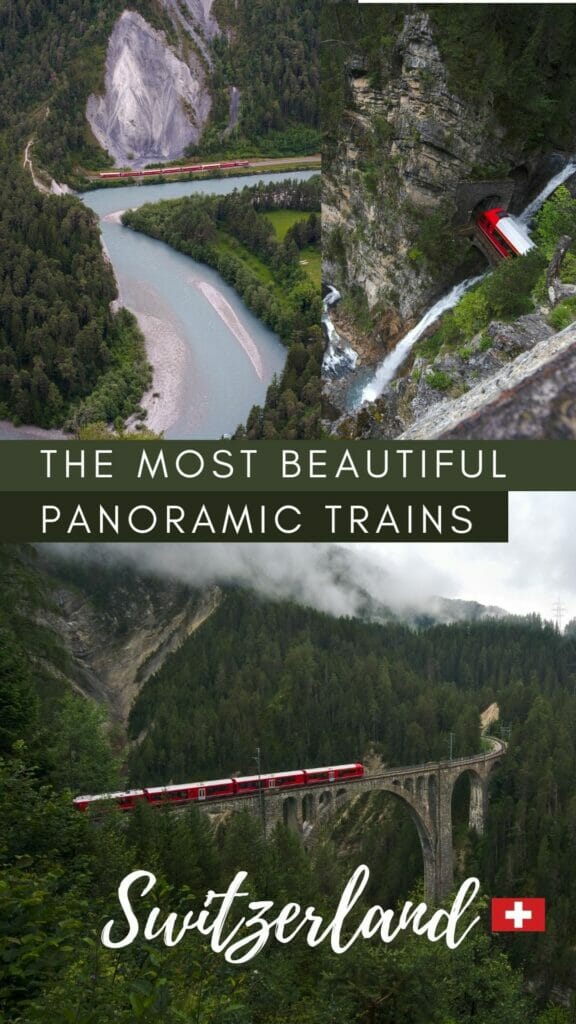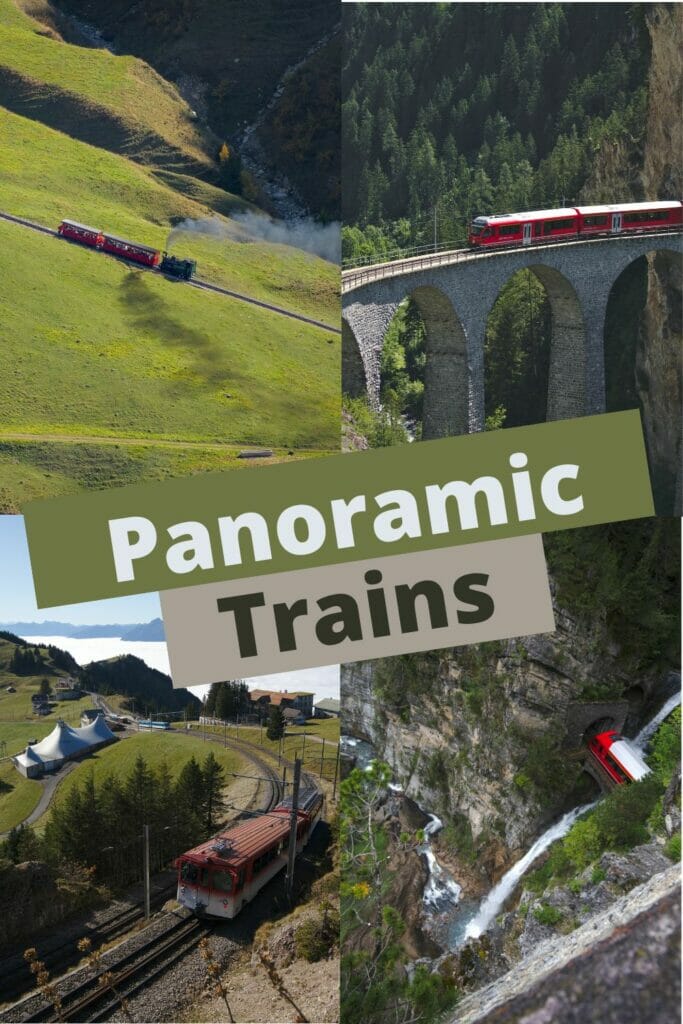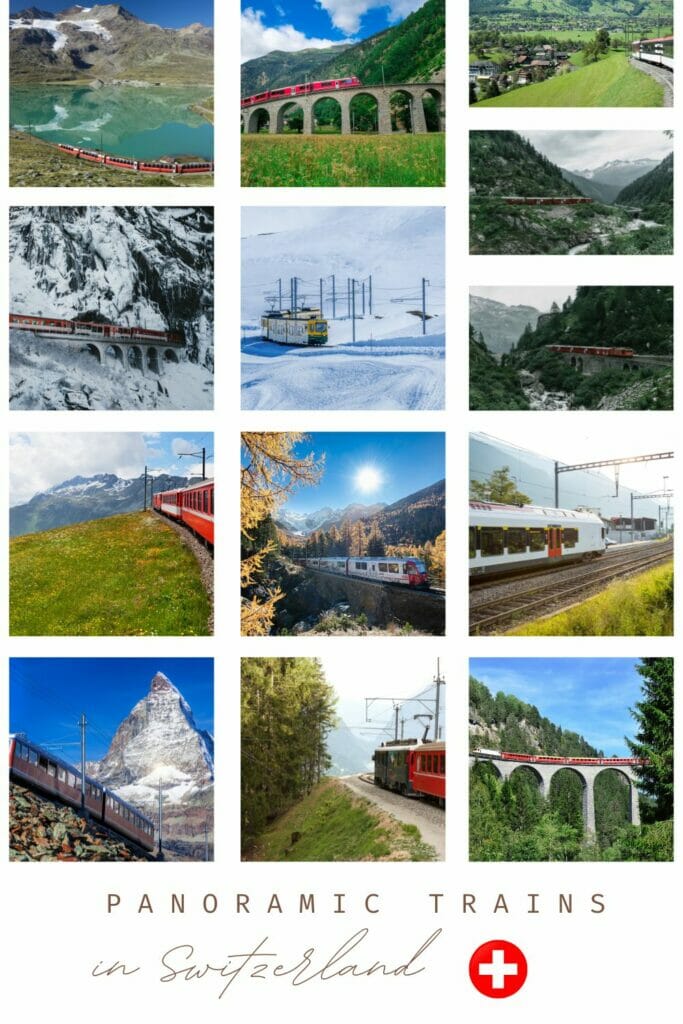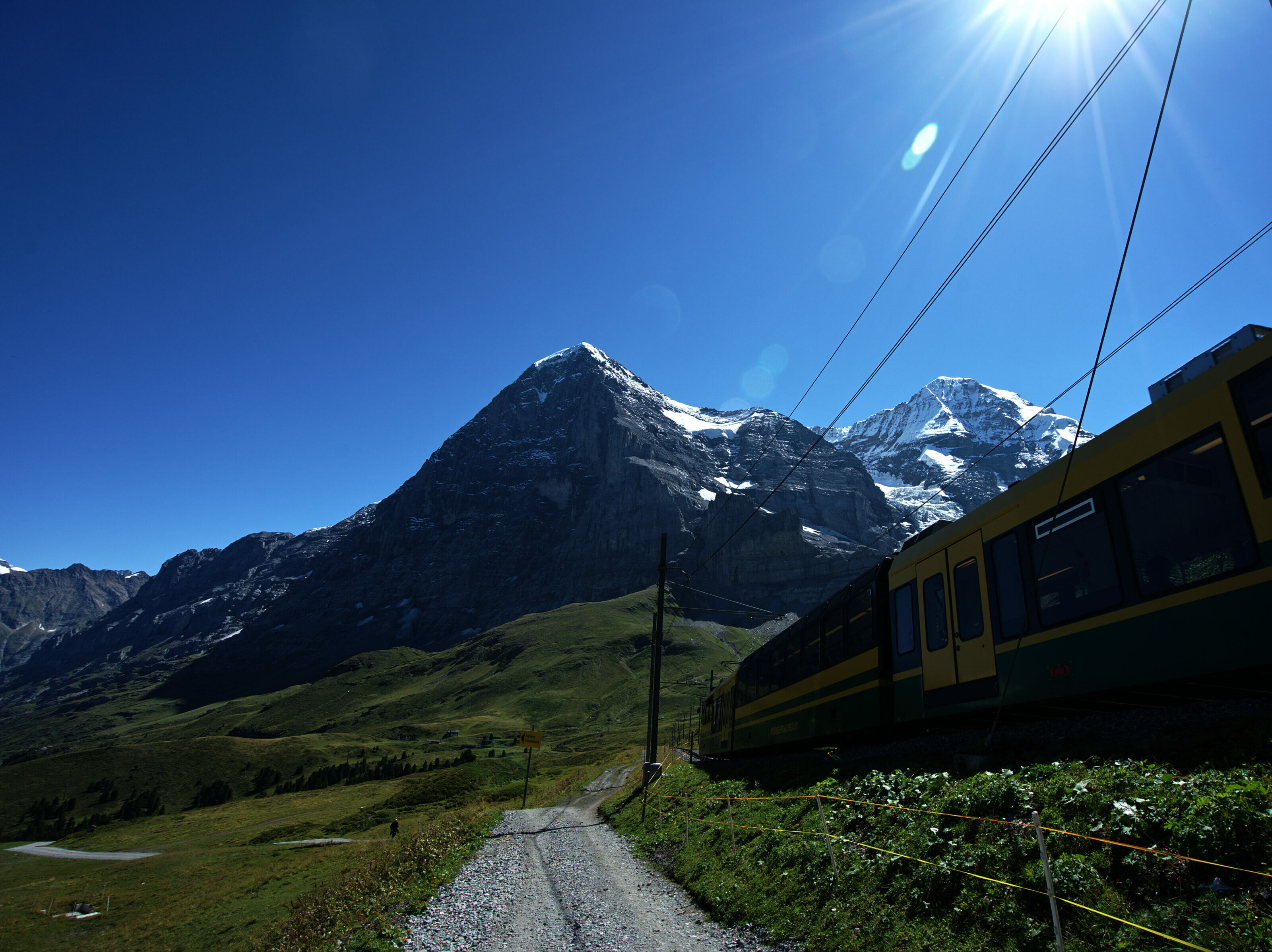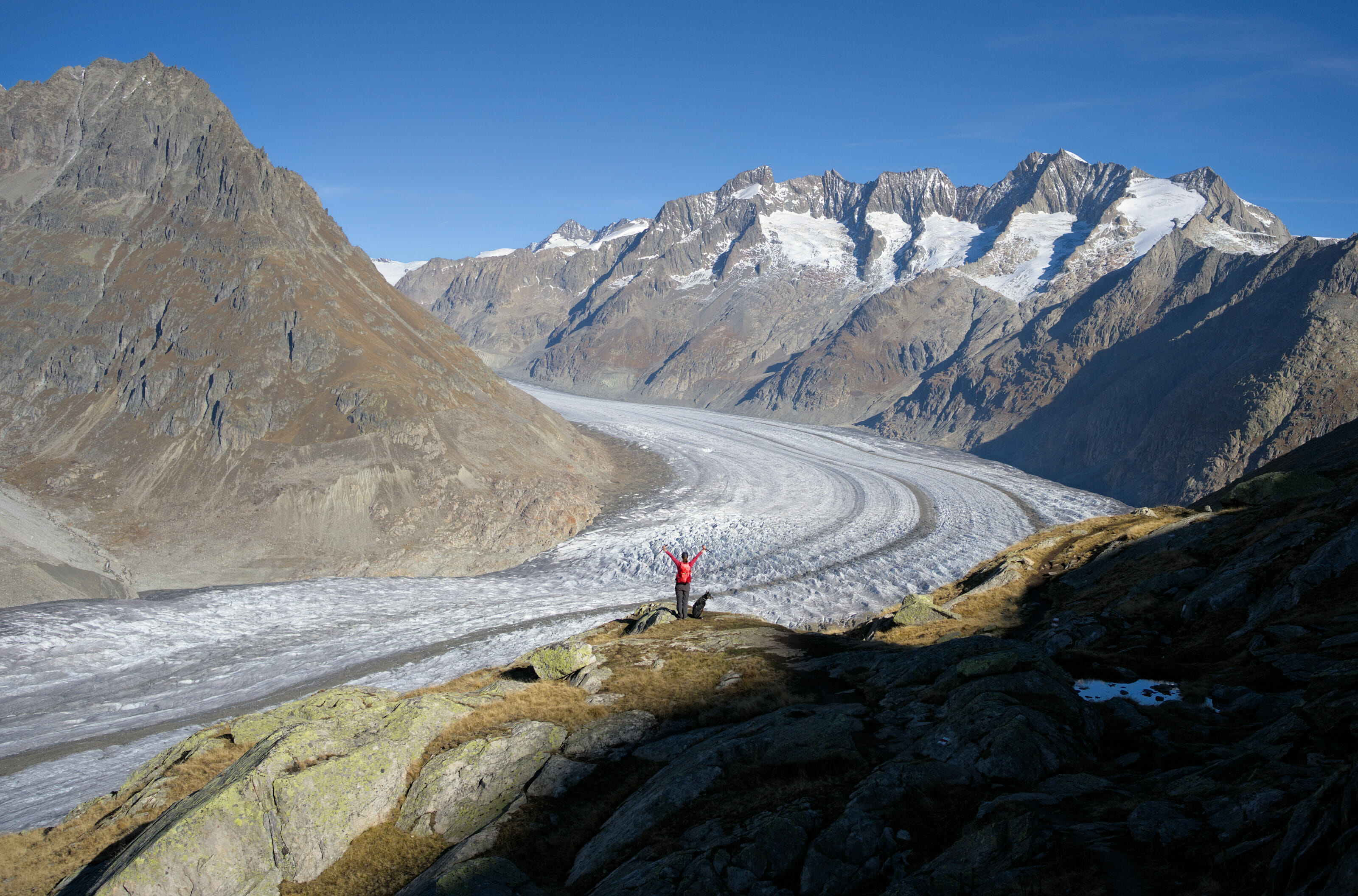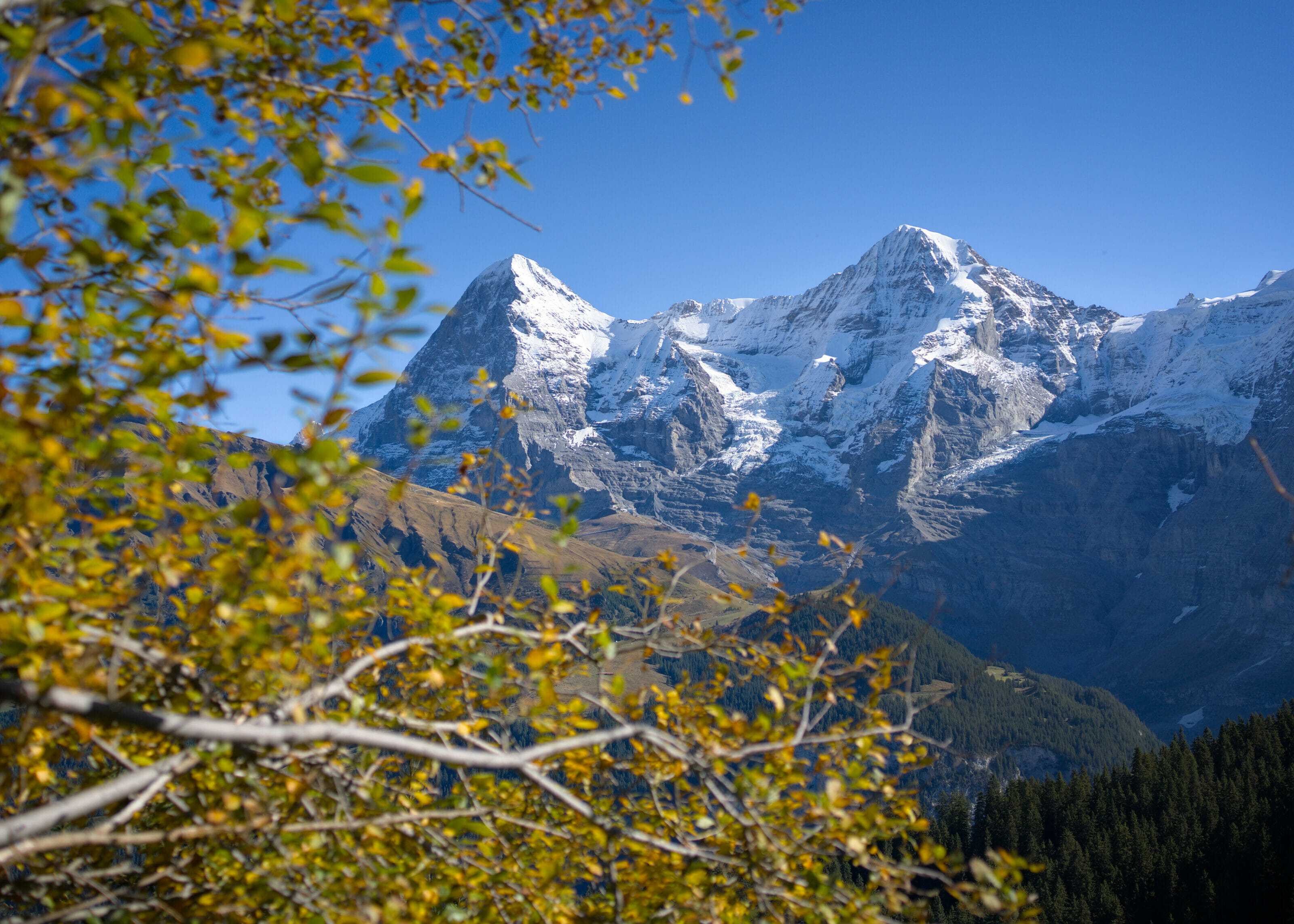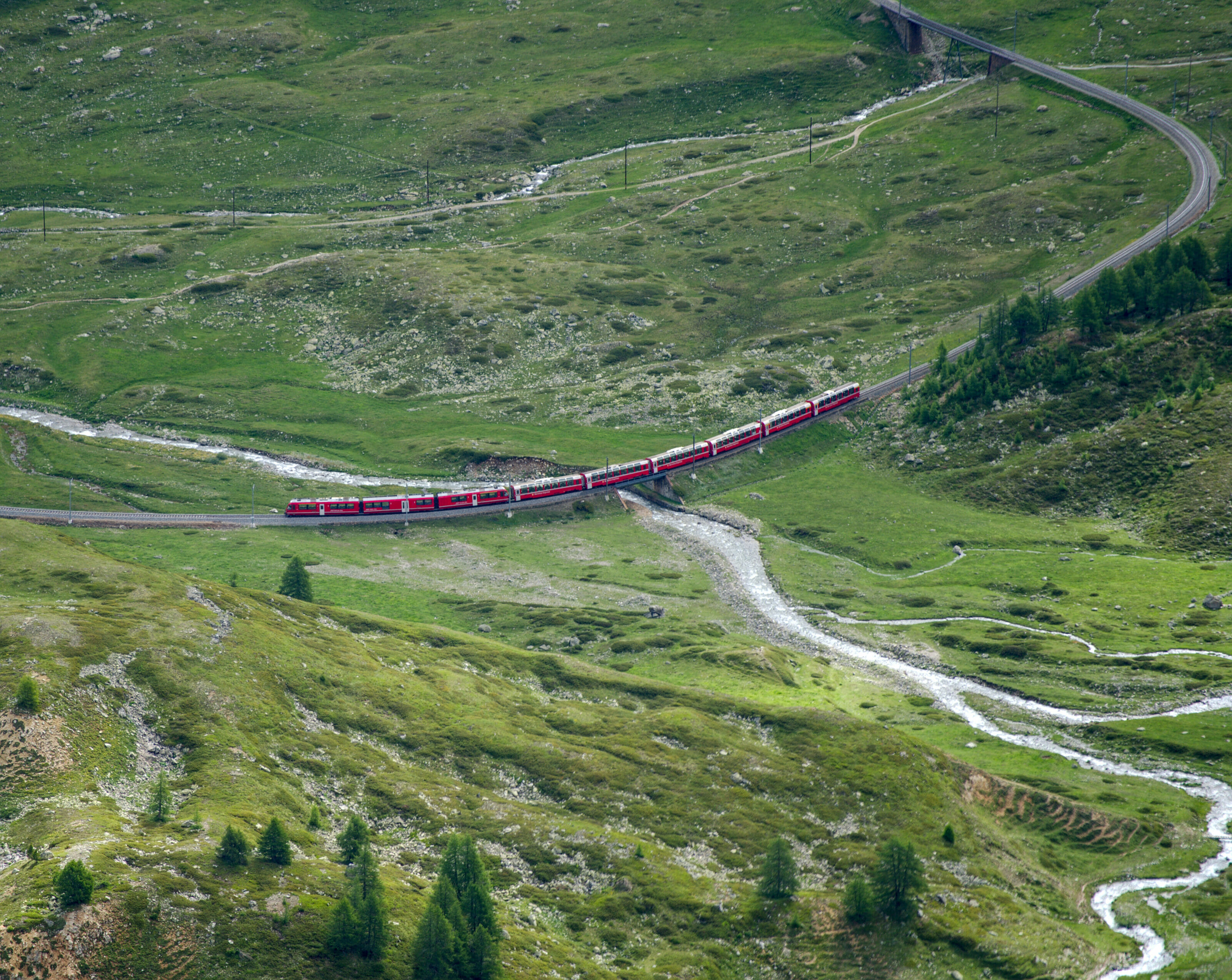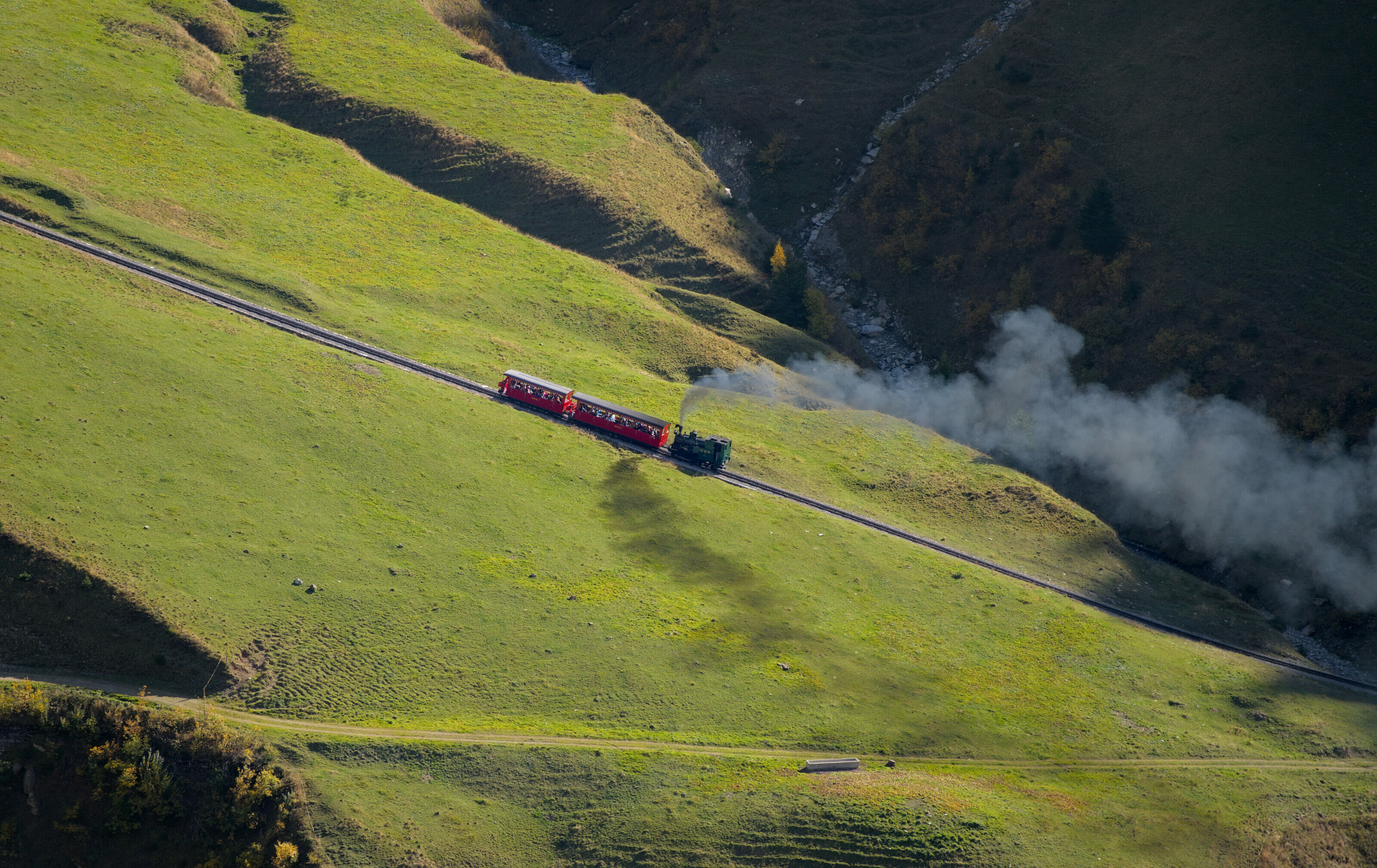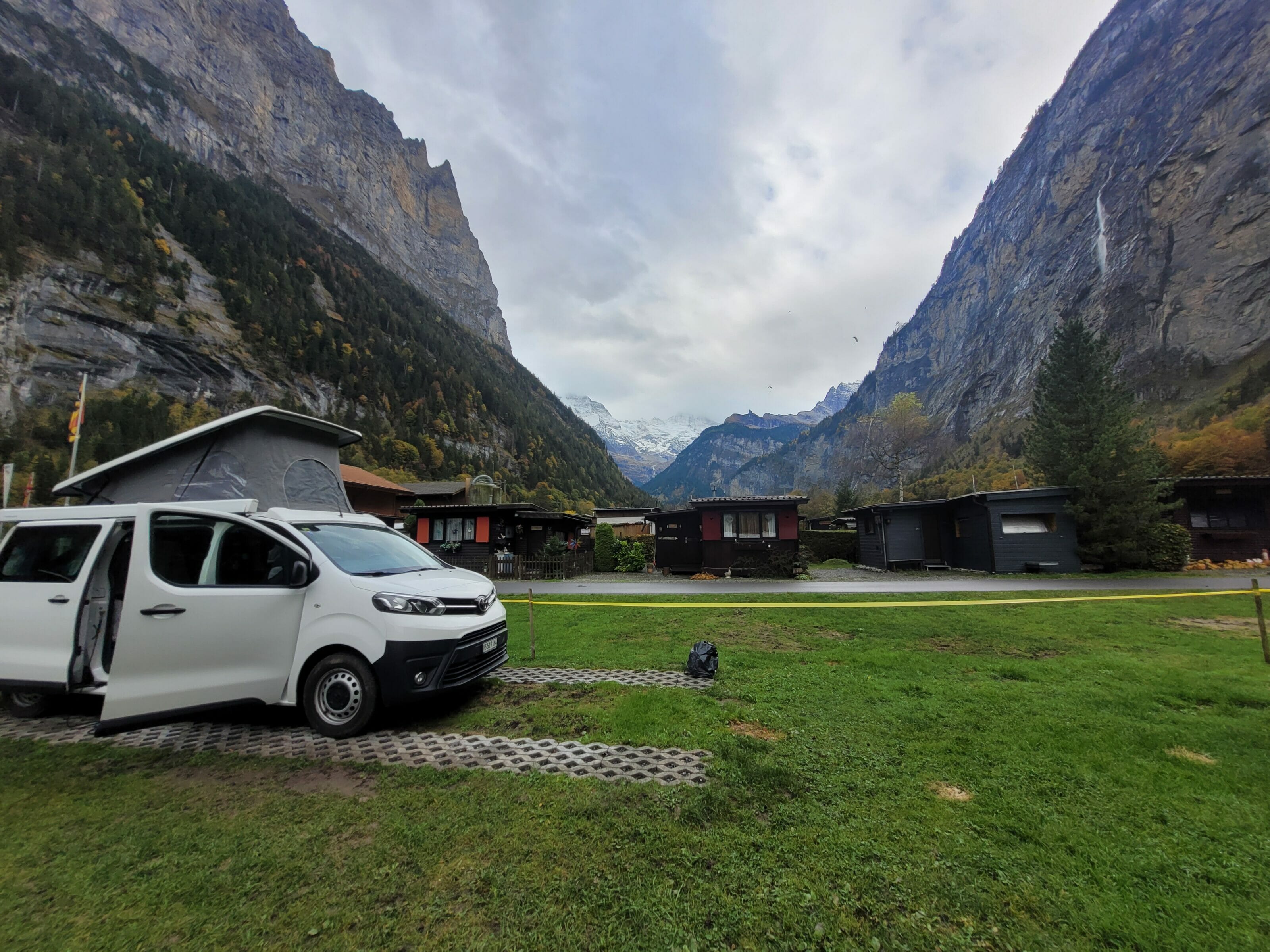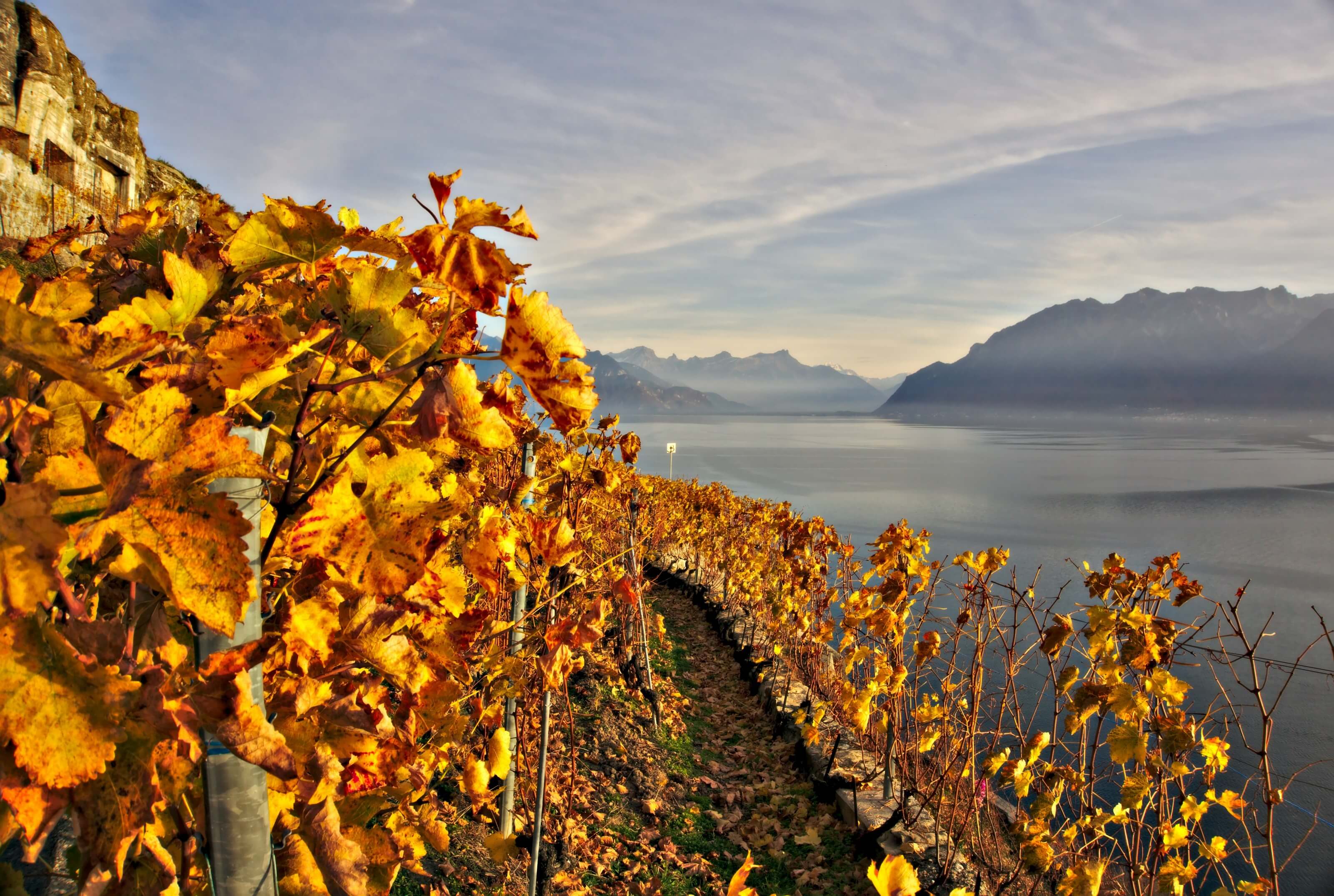After our article on how to buy train tickets in Switzerland and the one dedicated to the detailed comparison of the half-fare offer with the Swiss Travel Pass, we propose you a last 100% train article: our selection of the most beautiful panoramic trains in Switzerland.
The train is a means of transportation that we like very much and especially in Switzerland. During our 2 years in Zurich we had the GA (a bit like the Swiss Pass but in an annual version and intended for Swiss residents). During this period, we have assiduously travelled the Swiss railways. 🙂 We take you along?
- The Bernina Express
- The Glacier Express – the world’s slowest express train
- The train Lausanne – Villeneuve or Lausanne – Bern
- The Golden Pass from Montreux to Interlaken- MOB
- The Mont-Blanc Express panoramic train
- The Rigi
- The train betwenn Interlaken and Thun
- The Brienzer Rothorn
- All the way up to the top of Europe – JungfrauJoch
The Bernina Express
The Bernina is probably one of the most emblematic panoramic trains in Switzerland. Officially, the Bernina express allows to go from Chur to Lugano. It is important to note that the trip is not entirely by train, it is in fact a combination of train and bus. A first panoramic train covers the more than 100km from Chur to Tirano (in Italy) in 4 hours. Then, you change for a bus and there it is necessary to count 3 hours to reach Lugano.
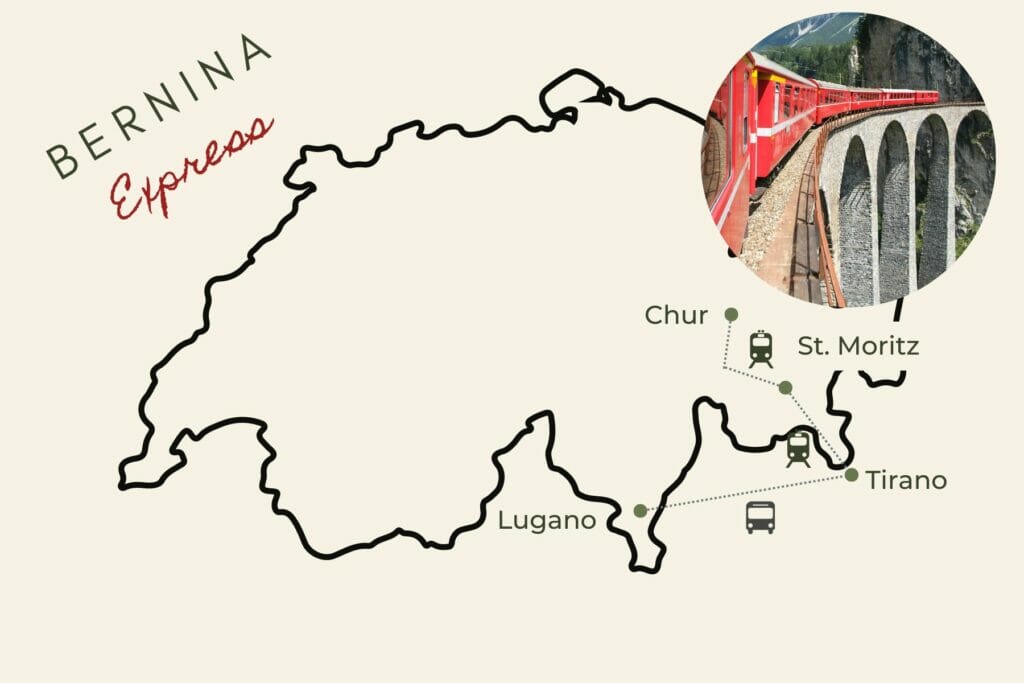
But what makes this train ride so famous? Well, quite simply the route! Between Chur and Tirano, the Bernina Express climbs to an altitude of 2253m and crosses some 55 tunnels and 196 bridges! One of the most famous bridge crossings is probably the “Landwasser Viadukt”. The Bernina Express slows down quite a bit on this viaduct in order to fully enjoy the landscape.
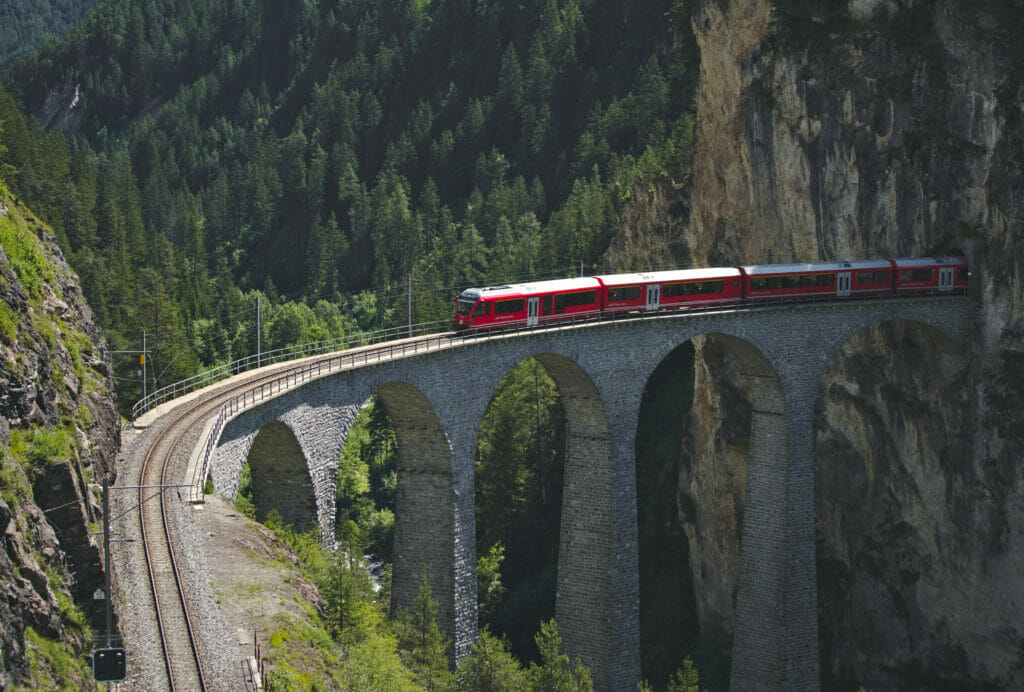
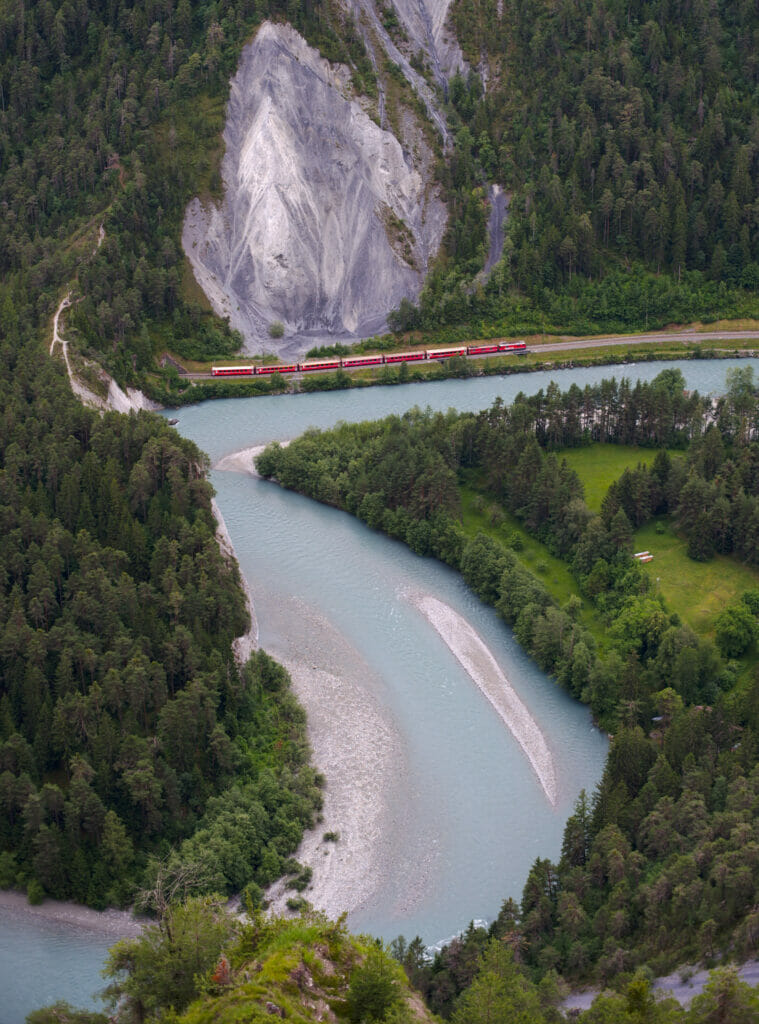
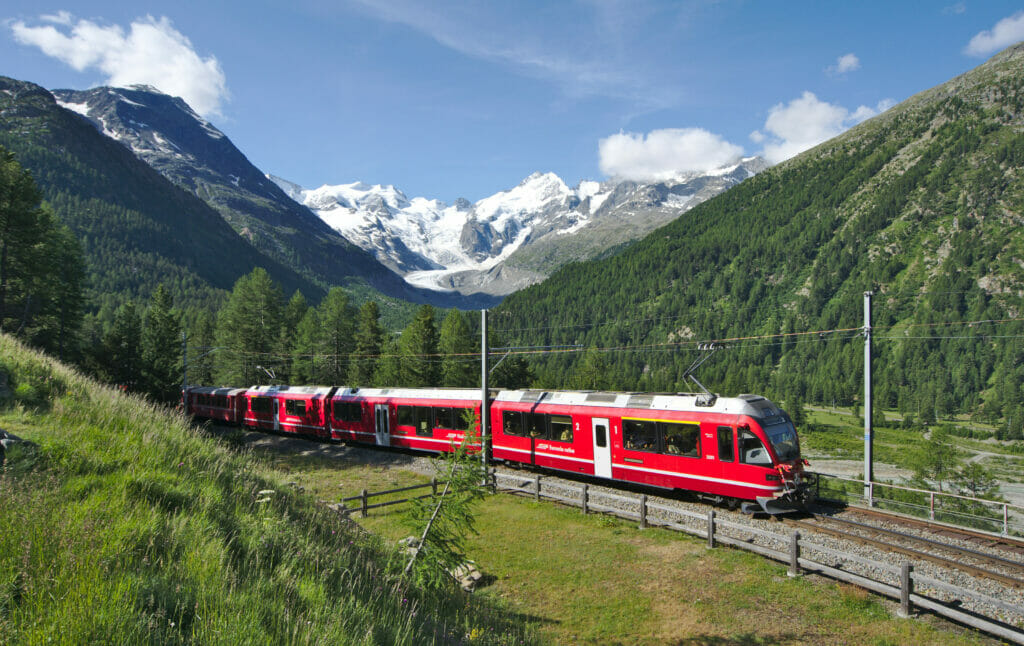
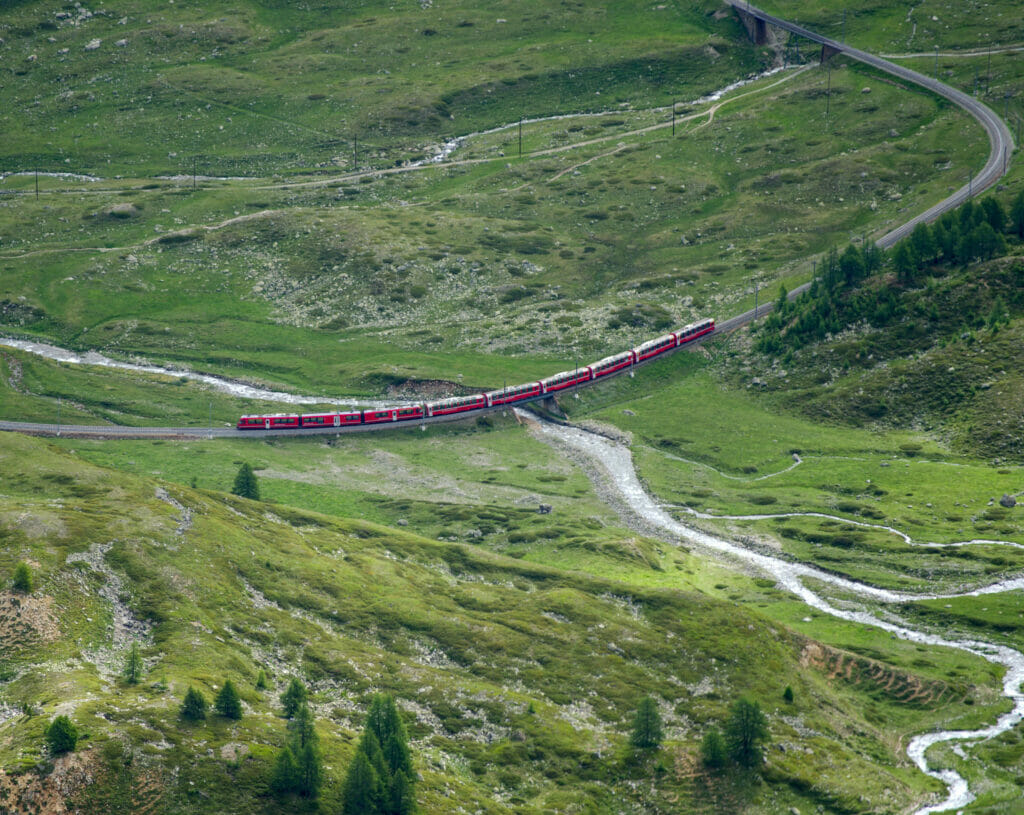
If you want to know more about the Landwasser viaduct, you can have a look at our article. We show you some more pictures and we also give you some ideas of walks to observe the different points of view on the viaduct 😉
Bernina Express prices: The journey from Chur to Tirano costs CHF 63 (CHF 31.5 with half-fare card) in 2nd class and CHF 111 (CHF 55.5 with half-fare card) in 1st class. In addition to the price of this ticket, a seat reservation (mandatory) costs CHF 20 if you take a panoramic train. This amounts to 83 CHF in 2nd class or 131 CHF in 1st class.
Note: this trip is included in the Swiss Travel Pass. But if you have the pass, you will still have to pay the seat reservation fee if you opt for the panoramic train.
The Bernina Express runs on the same route as conventional regional trains. Only a limited number of trains per day are “Bernina Express” (depending on the season). The other so-called “classic” trains follow the same route but have “standard” windows. Seat reservations are not required for the classic trains. Basically, the 20 CHF reservation fee is to be seen as the “premium” for the large panoramic windows. It’s up to you if you want to have the big windows and pay the extra 20 CHF or just take the “normal” train.
Personally, I would tend to favor the classic. Why? Because for the Bernina it can be necessary to book your seat several months in advance… and well… in the mountains the weather is not always good! With the classic train you can buy your normal ticket at the last minute once you know the weather forecast. The windows are not as big, there are no “tourist infos ” on the loudspeakers but… I reassure you, you can still see the landscapes 😉
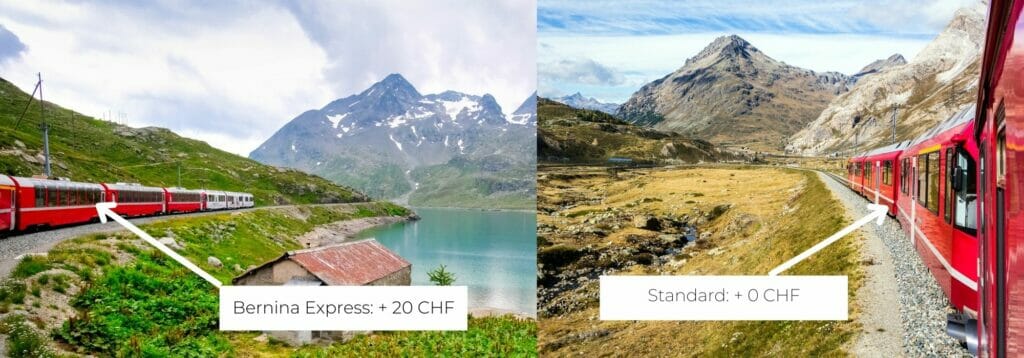
The Glacier Express – the world’s slowest express train
When we talk about panoramic trains in Switzerland, the two that often stand out are the Bernina and the Glacier Express. This is not just marketing, because these two lines are simply incredible! After that, you will see in the following article, there are many others to discover 😉 But before going on, let’s take a look at the one that is often called the slowest fast train in the world.
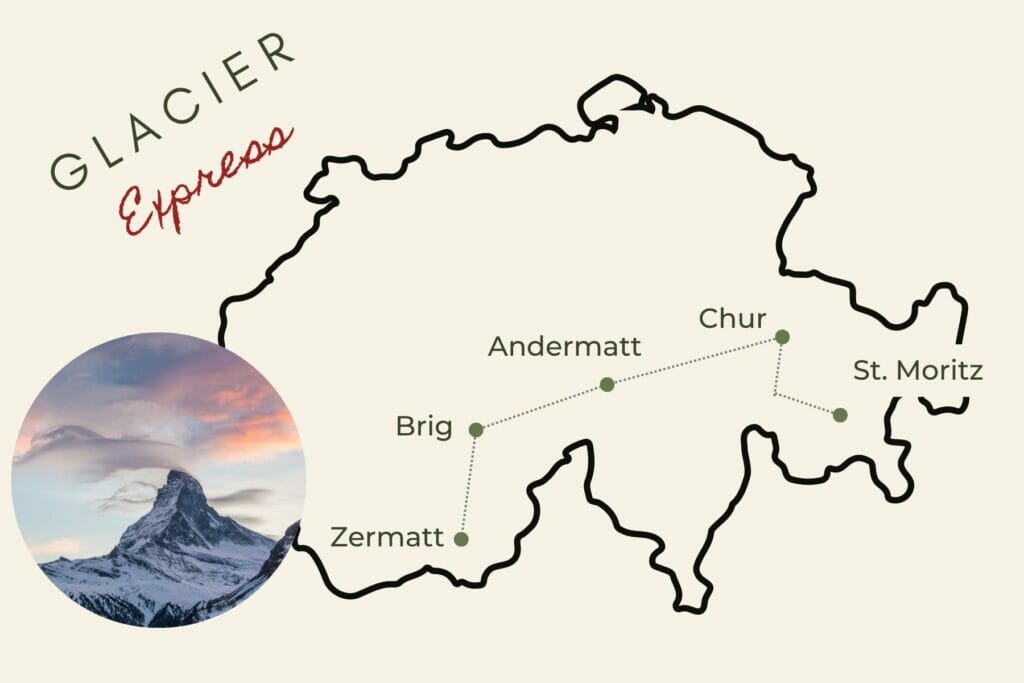
The Glacier Express is a line that runs from Zermatt in the canton of Valais to St.Moritz in the Grisons, two emblematic (and premium) ski resorts 😉
The highlight of this route would probably be the crossing of the Oberalppass, a pass at 2000m altitude also known as the source of the Rhine. From Chur, the Glacier Express follows the same route as the Bernina, i.e. you will also pass over the Landwasser Viadukt and all the other incredible viaducts on this stretch.
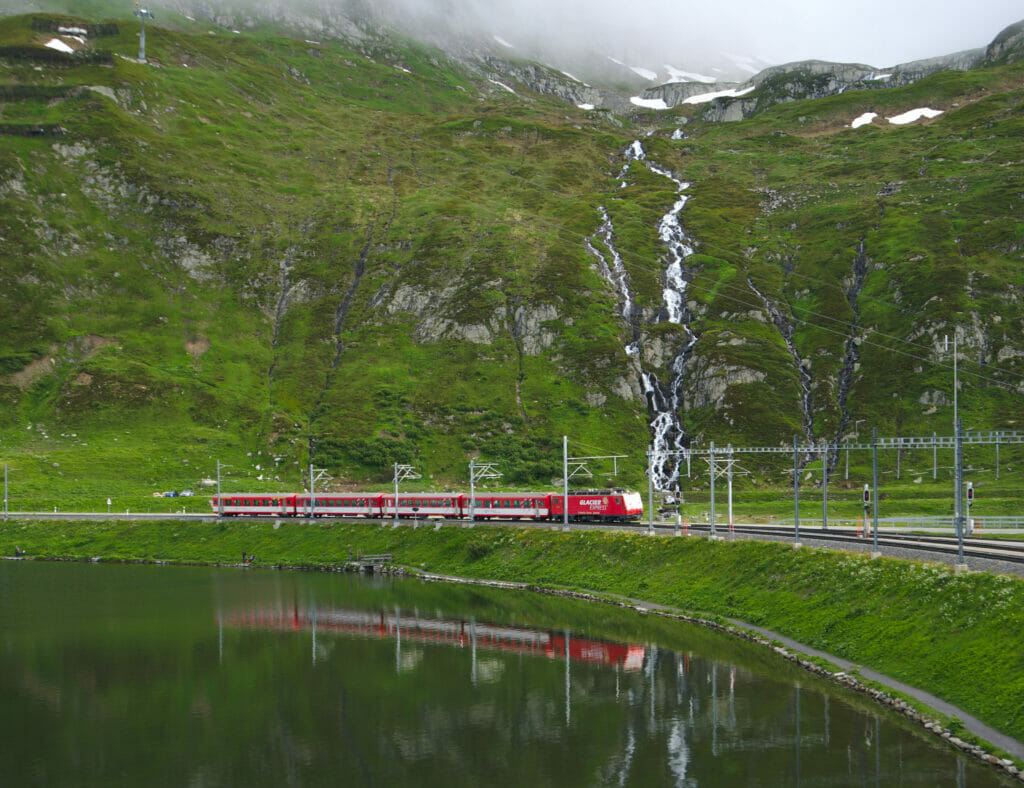
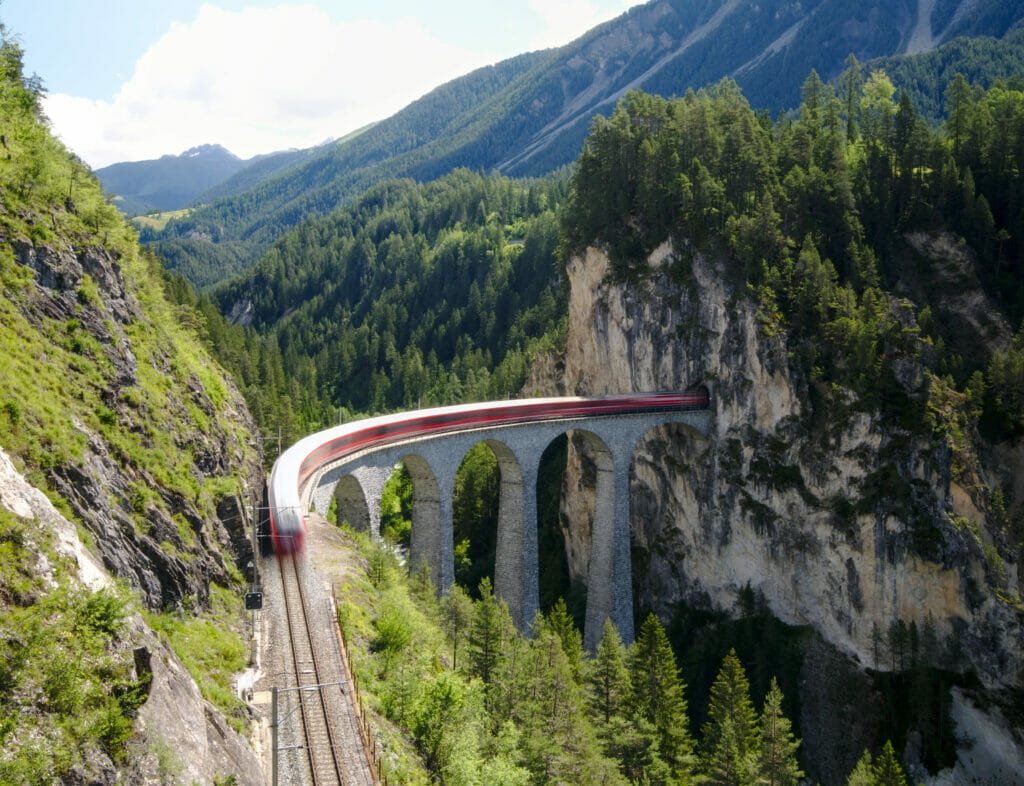
As for the Bernina, it would be quite possible to follow the same itinerary by taking “classic” trains, but you have to know that this will imply between 4 and 6 changes depending on the schedule. In short, if you plan to make stops on the way (especially in Fiesch, Andermatt or Chur) then the “ordinary” trains are a very good option, but if you want to do the whole trip in one go, then it is better to take the Glacier Express (travel time: about 8 hours). In winter there is 1 connection (in each direction) per day and in summer there are 2. There are additional connections but they do not cover the whole route (from Zermatt to Chur or from St-Moritz to Brig). Find all the timetables here.
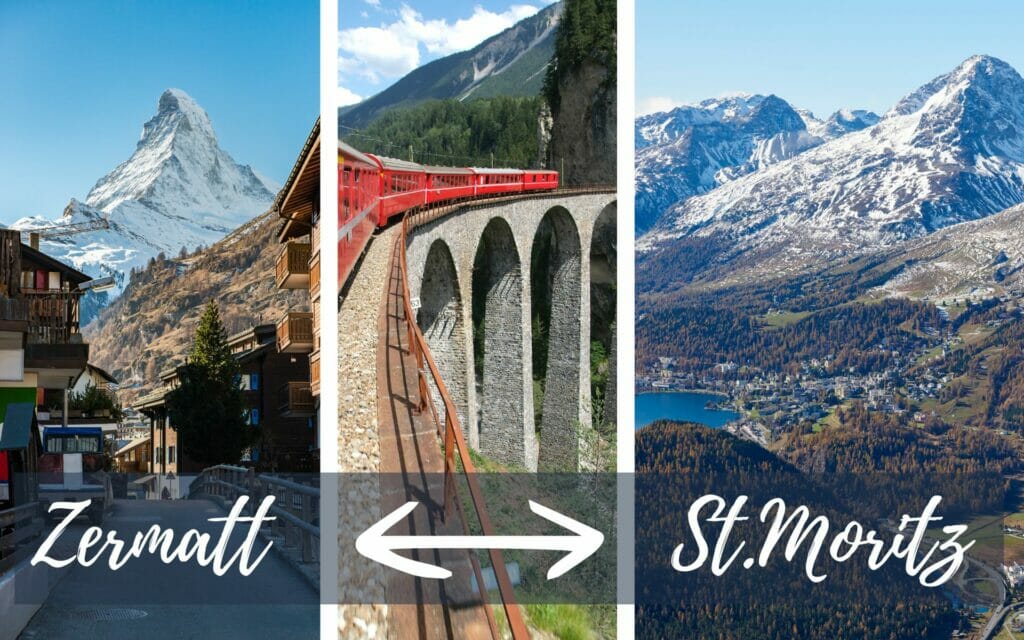
Fare: as with the Bernina, the Glacier Express is a train that requires a reservation (from 39 CHF to 49 CHF depending on the season). The journey itself is covered by the GA or Swiss Travel Pass. Without a pass, the standard price for the complete journey (Zermatt-St.Moritz or the other way) is 152 CHF in 2nd class or 268 CHF in 1st class. With a half-fare card, you get 50% off this price.
This article contains affiliate links to GetyourGuide to buy the Swiss Travel Pass. By using our links you don’t pay anything extra (it’s even a little bit cheaper on Getyourguide than directly) but we will get a small commission. The affiliate links help us to offer you free, independent and ad-free content.
The train Lausanne – Villeneuve or Lausanne – Bern
Here we leave the world of the “official” panoramic trains and go to a “standard” line that we particularly like. In fact, here I’m not going to suggest you one line but two: the trains that leave Lausanne in direction of the east and that cross the vineyards of Lavaux (UNESCO world heritage).
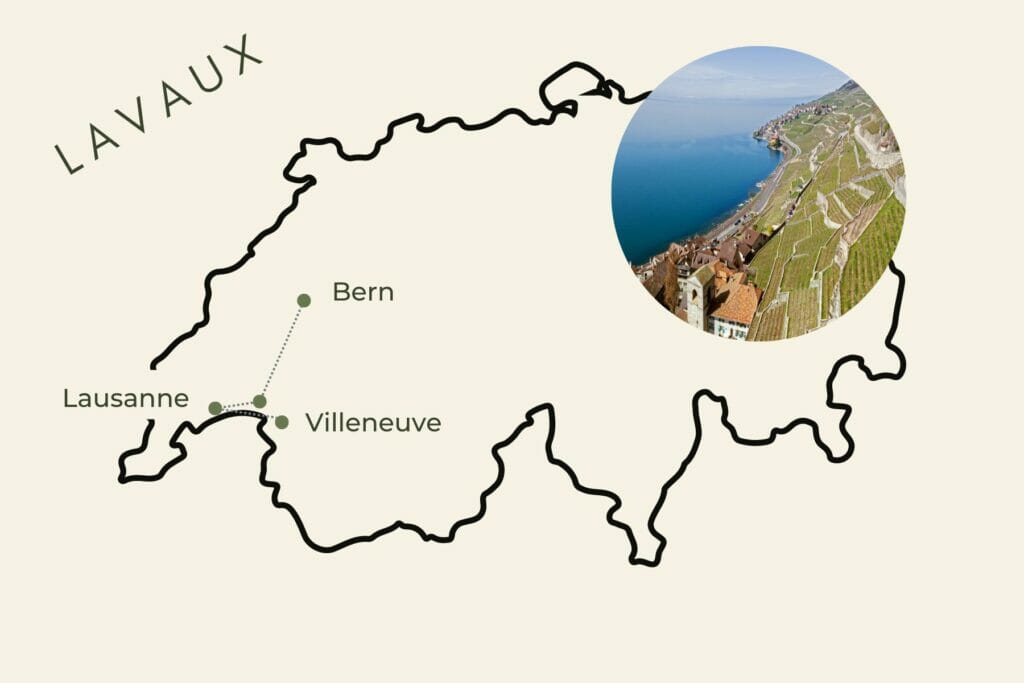
In fact, there are two train lines that pass through these incredible landscapes. On the one hand, the line going from Lausanne to Bern. Here the tracks run along the vineyards on their high part and you can enjoy an exceptional panorama on the lake with the Alps in the background. The view is just incredible, but the pleasure is “relatively” short-lived. At the level of Puidoux, the train turns left in the direction of Bern and after a tunnel passage we arrive in the countryside of Fribourg.
The second line, the one that runs from Lausanne to Villeneuve (and then to the Valais), runs along the lake shore. At several moments, the tracks are really at the edge of the water and we have a front row seat to admire the Alps!
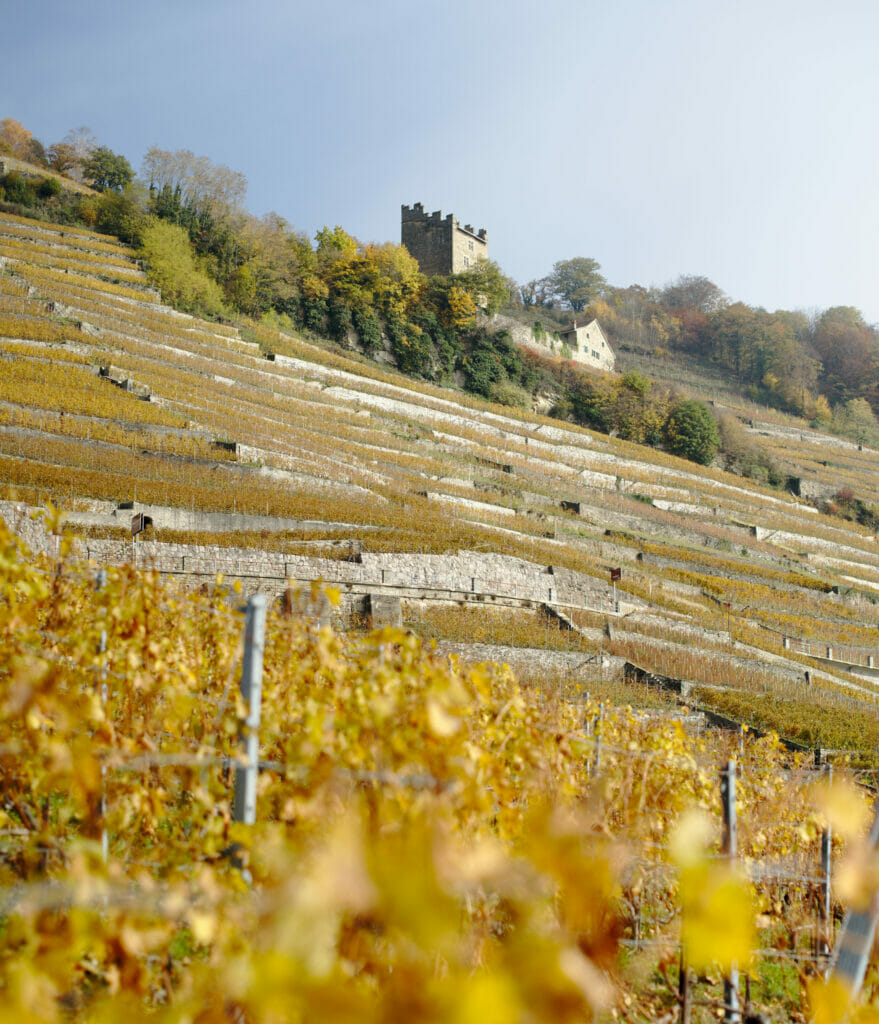
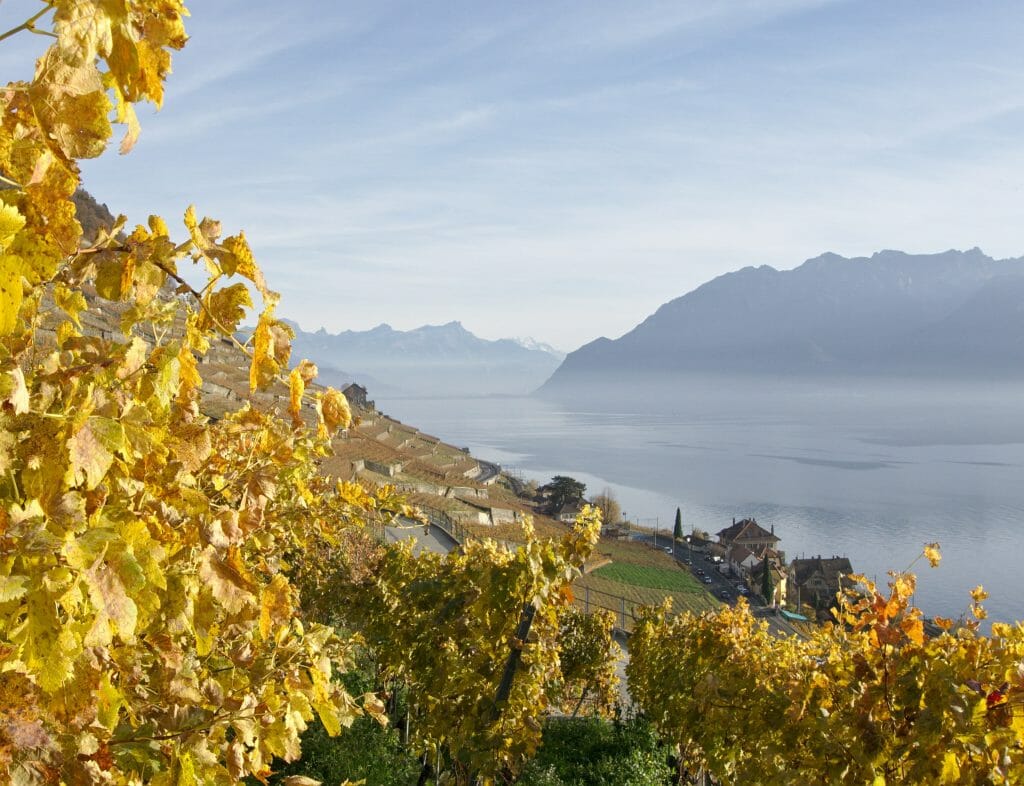
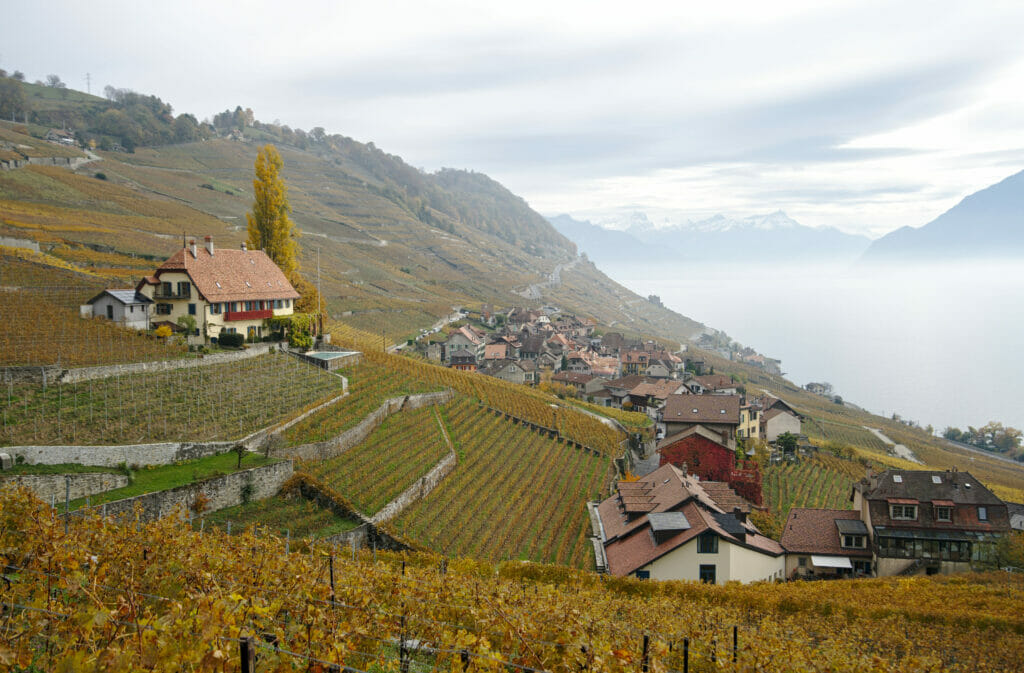
Honestly, if I had to choose between the two, I wouldn’t know… The first one allows you to have a view from the top of the vineyards and that, believe me, is really incredible. The second line allows you to stay longer in this scenery and to pass by the beautiful towns of Vevey and Montreux.
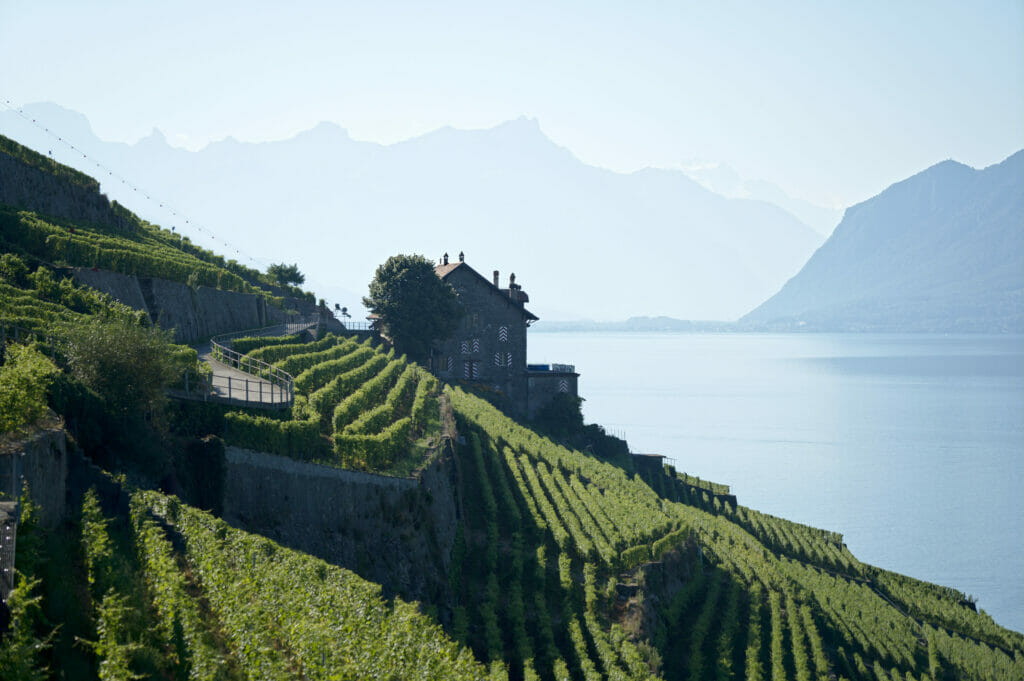
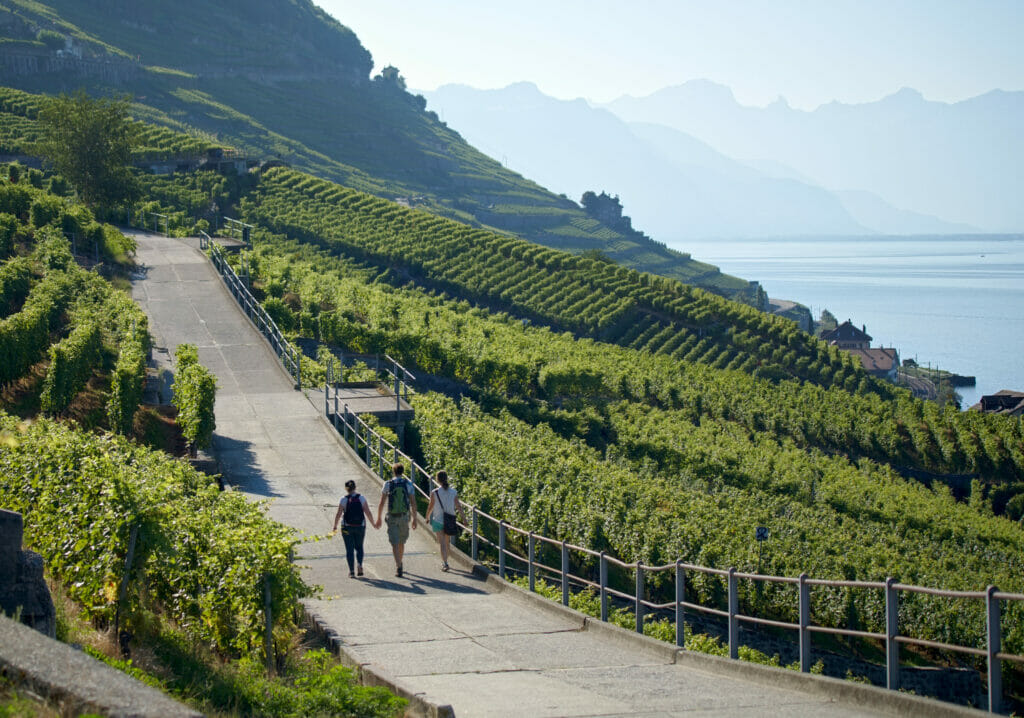
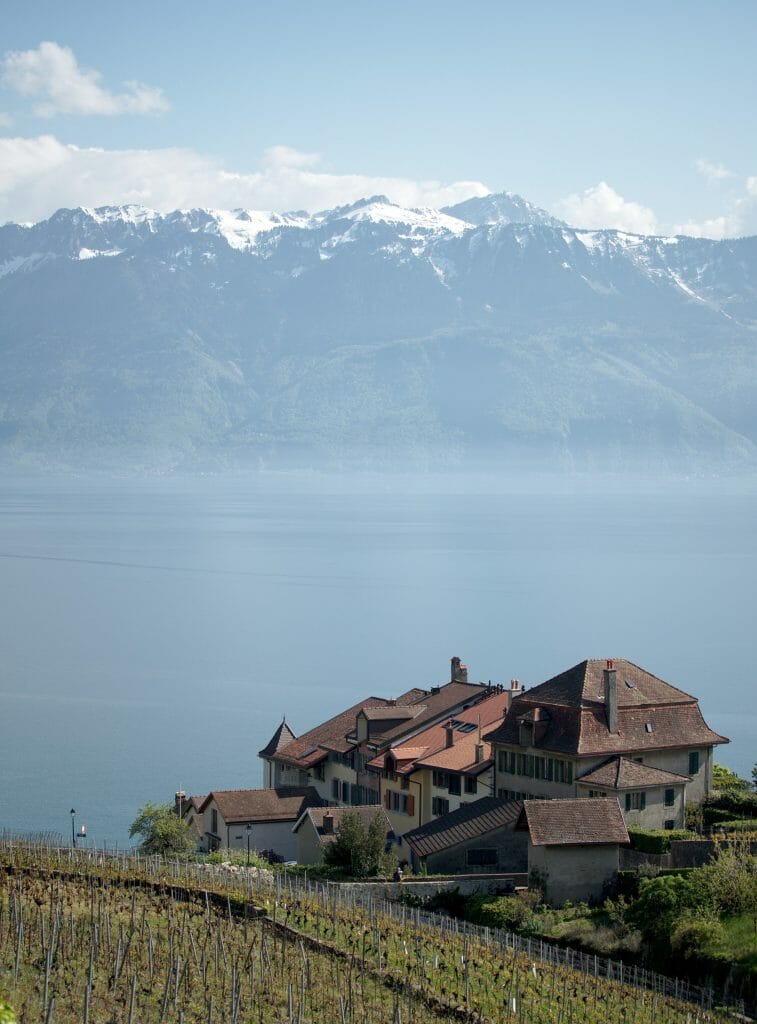
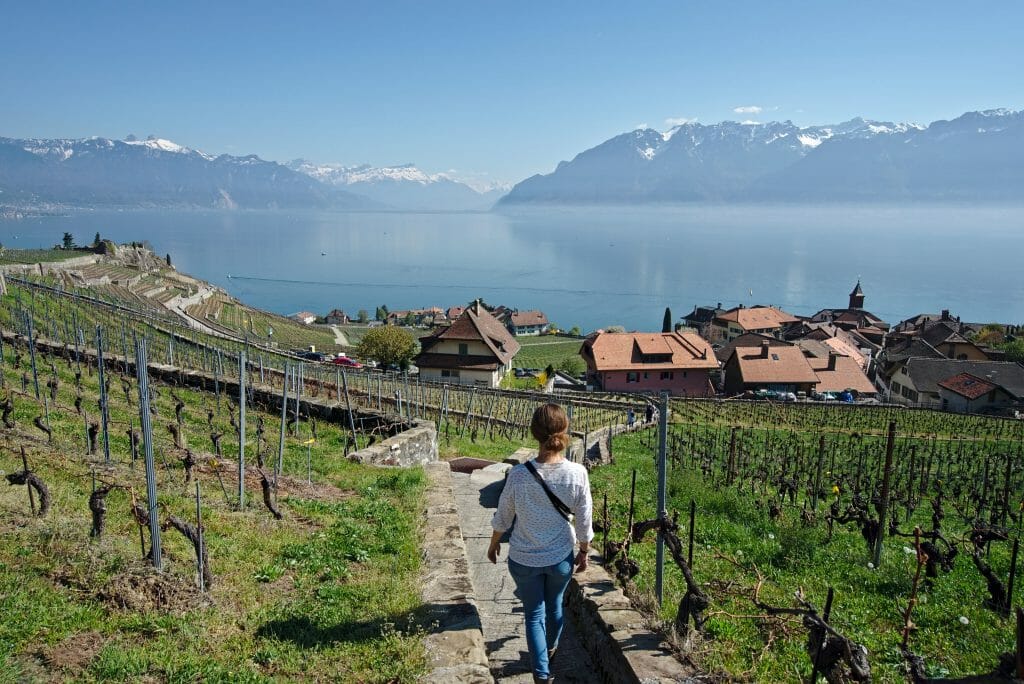
If you are traveling by train and want to go for a ride, we recommend you to have a look at our article on the Lavaux, we propose several itineraries from station to station.
The Golden Pass from Montreux to Interlaken- MOB
This route is a great classic of the Swiss panoramic trains. In fact, it is often quoted as a must for several years and it’s funny because until December 2022 it was in fact impossible to do the whole route without changing train at some point. Since December 11th of 2022, a new train has arrived and it allows to connect Interlaken to Montreux without any change.
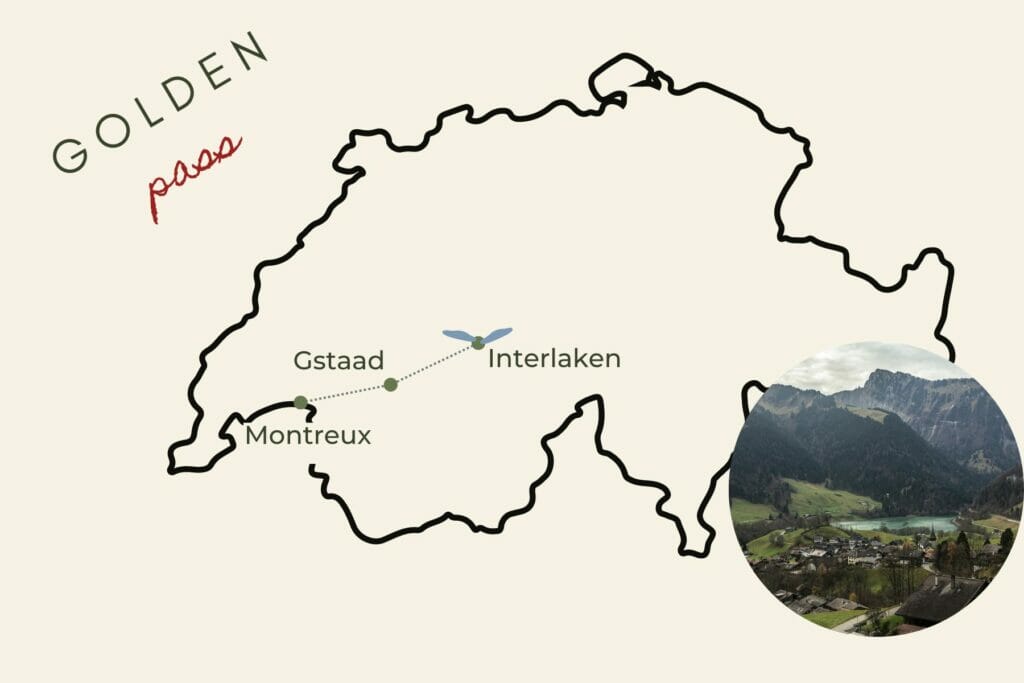
Here seat reservations are not required, so there is no extra charge for holders of a GA or Swiss pass. As is the case with the Bernina Express, this train runs on a “classic” route, so there are many connections per day. At present, however, there is only one “official” Golden Pass return trip per day. From summer 2023, there will be 4 round trips.
Afterwards, if the schedule does not suit you or if you want to be sure to have a seat (the direct being clearly the most popular), it is also possible to take this same line with the “normal” trains. The only difference is that you will have to change trains twice, once in Zweisimmen and again in Spiez (the travel time is only 20 minutes longer).
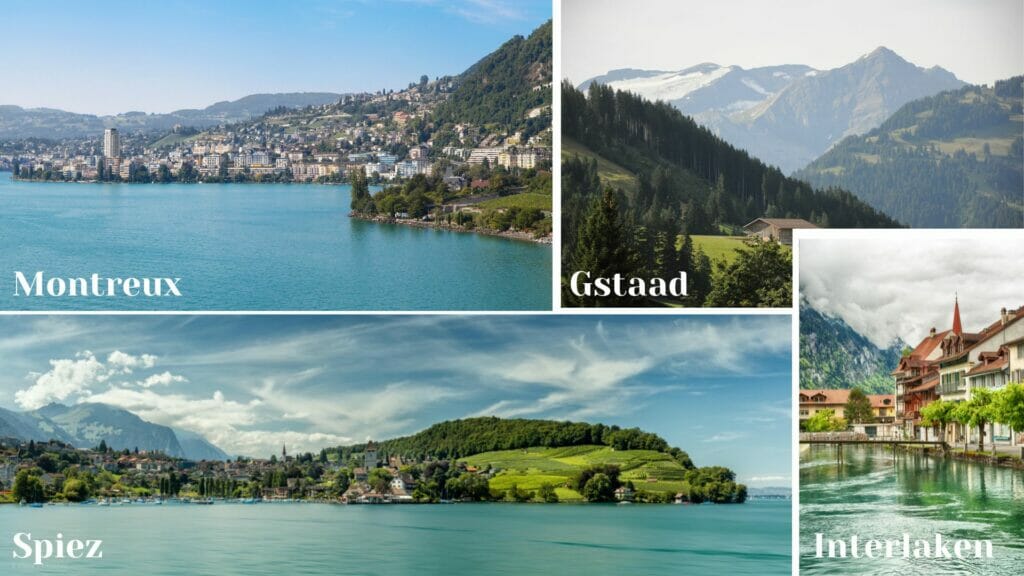
We know this route well! At one time, the company I worked for in Zürich had its headquarters in Gstaad and we regularly made the trip (either from Interlaken or from Montreux).
Tip: if you buy the ticket on the SBB website, put as departure Montreux and as destination Interlaken (or vice versa) but also indicate the option “Via Gstaad”. Otherwise, the system will suggest you to go via Visp (a faster route but not following the mythical Golden Pass route).
Fare: included in the GA or Swiss pass. If you don’t have a Swiss pass, then a one-way ticket costs CHF 53 in 2nd class or CHF 93 in 1st class (the price is half with the half-fare card as on all official Swiss train lines)
The Mont-Blanc Express panoramic train
Another line that is not “officially” part of the panoramic trains, but believe me, you won’t regret taking it 😉 Departing from Martigny, the Mont-Blanc Express is the result of a collaboration between the CFF (Swiss trains) and the SNCF (French trains).
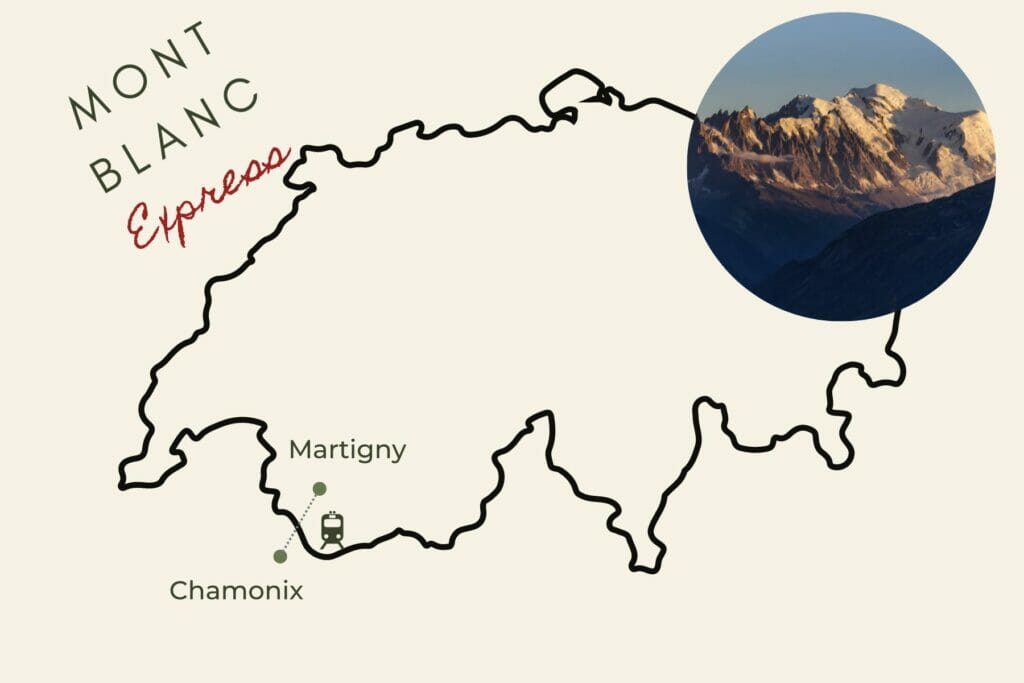
We took this line several times to get to Finhaut, unfortunately we didn’t think to take pictures of the view from the train, but you can take our word for it, it’s very beautiful! 🙂
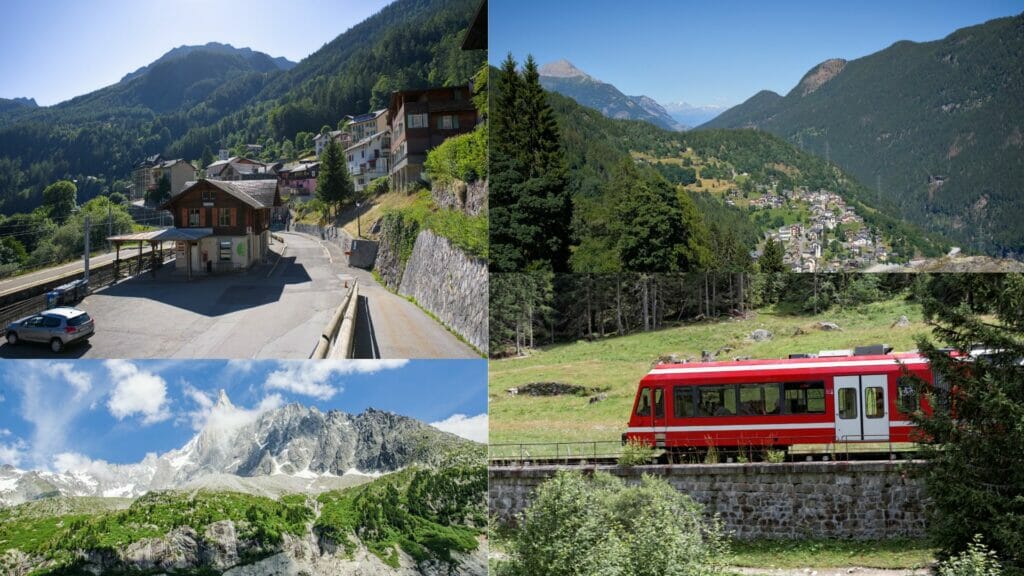
But be careful, this train is international. If you travel with a GA or a Swiss Travel Pass, the latter will only be valid up to the Châtelard border. You will have to buy a ticket for the part going from the border to Chamonix 😉
And if you come to the region and are looking for an idea for a hike, we advise you to have a look at our article on the hike from Finhaut to the Emosson dam.
The Rigi
We continue with the panoramic trains with the one that is probably one of the best known and has the particularity of being a cog railway: the Rigi.
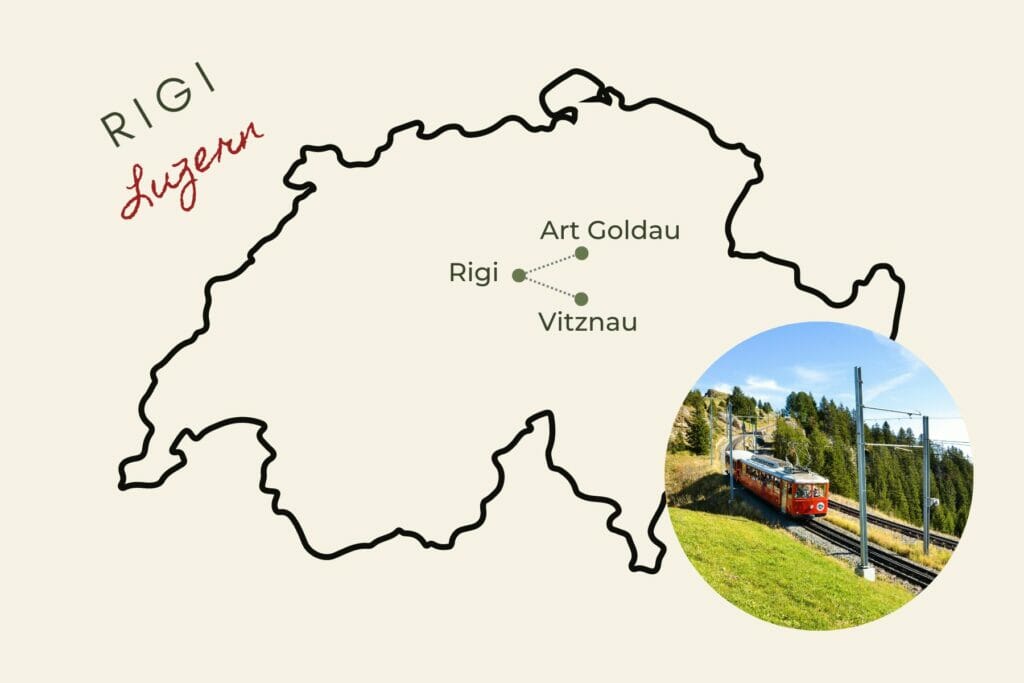
In fact, when we talk about the train that goes up to the Rigi, it is actually useful to specify which one, because there are 2 lines that reach the summit:
- The Vitznau – Rigi Kulm line: a magnificent route that allows you to come to Vitznau by boat from Lucerne and then to comfortably sit in the cogwheel train to the summit. Travel time by train: 30 minutes
- The Art Goldau – Rigi Kulm line: This line arrives from the other side of the mountain (so not from the side of the lake of the 4 cantons), but rest assured, the view on the way and especially at the top is just as spectacular.
A good idea if you really want to enjoy the scenery 200% would be to take the boat from Lucerne to Vitznau, go up with the cogwheel train, hike to the top and then go down the other side towards Art Goldau. From there, it is easy to return to Lucerne on a “classic” train.
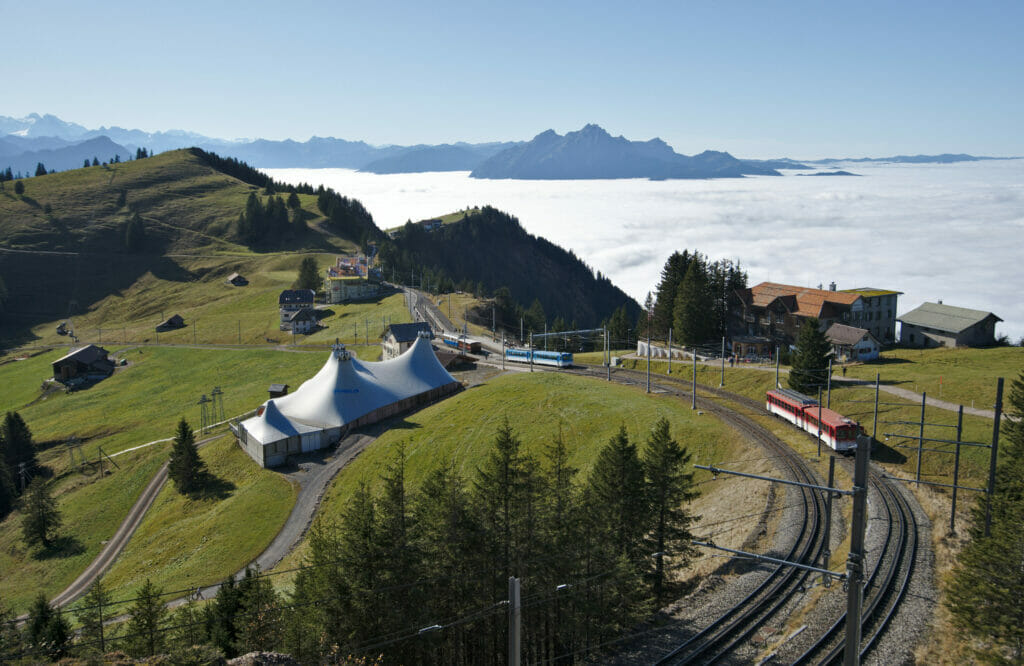
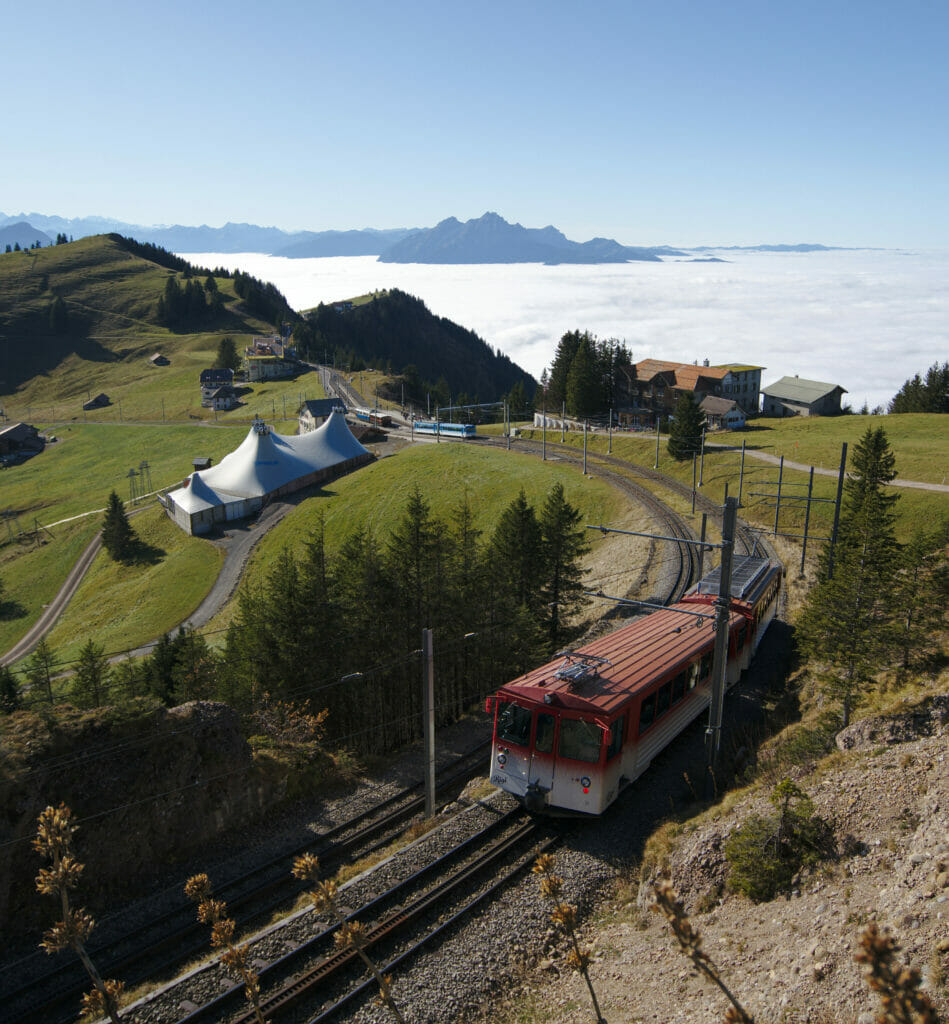
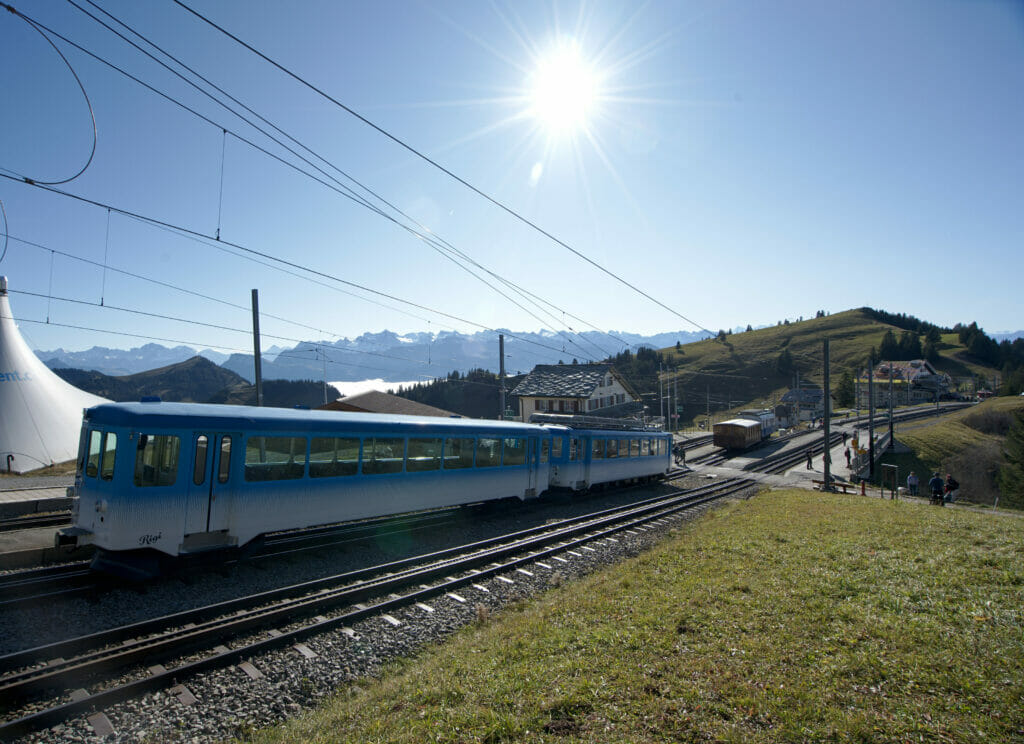
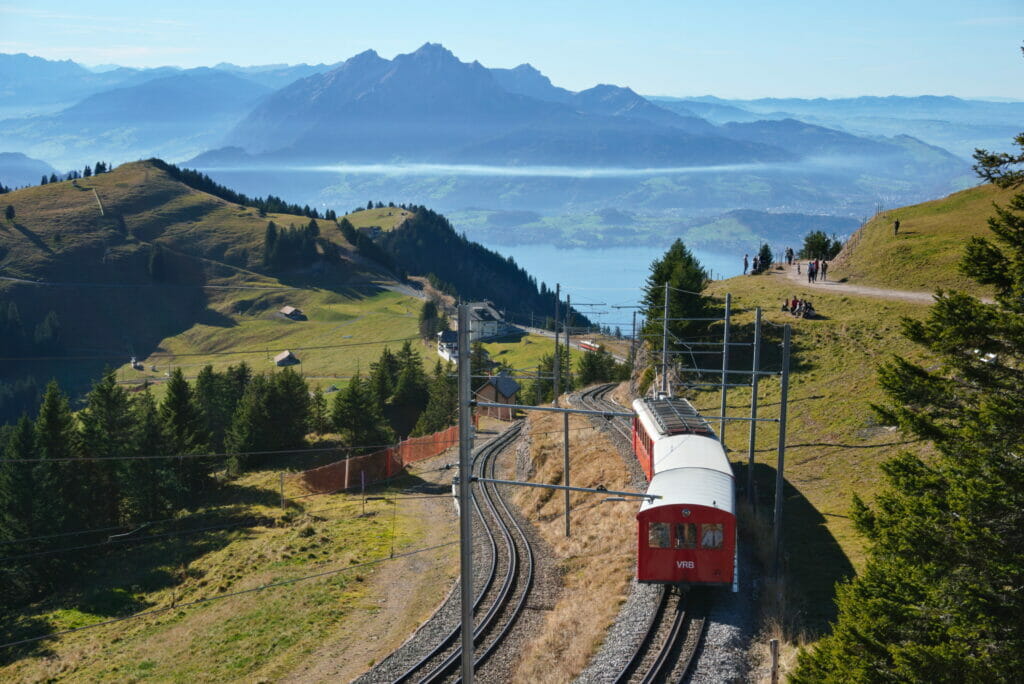
These cogwheel trains have the particularity of being part of the public transport network, which means that both the train and the boat trips are included in the Swiss Travel Pass or GA (often the cogwheel trains are private lines and therefore a supplement is applicable).
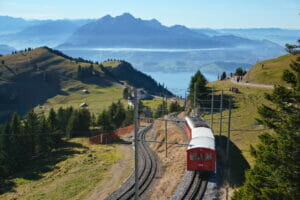
For the record, the cogwheel train that connects Vitznau to the Rigi is known to be the very first cogwheel train in Europe. Invented by a Swiss engineer, Niklaus Riggenbach, it was put into operation for the very first time on May 21, 1871! It is on this same rack system (called Rigenbach) that was built the first subway of Lausanne connecting Ouchy to the city center.
And if you are looking for hikes in the area, we recommend our article on a hike in the Rigi or the hike from Rigi Scheidegg to Rigi Kulm (a combination of cable car and train).
The train betwenn Interlaken and Thun
Here we are again on a “classic” train line and not an officially panoramic one (at least if we refer to the description of our dear tourist office). Well I decided to include it anyway, na! 🙂 A bit like the line that crosses the vineyards of Lavaux, the route from Interlaken to Thun is really beautiful! In fact, the line runs all along the lake of Thun and offers a breathtaking view on the mountains.
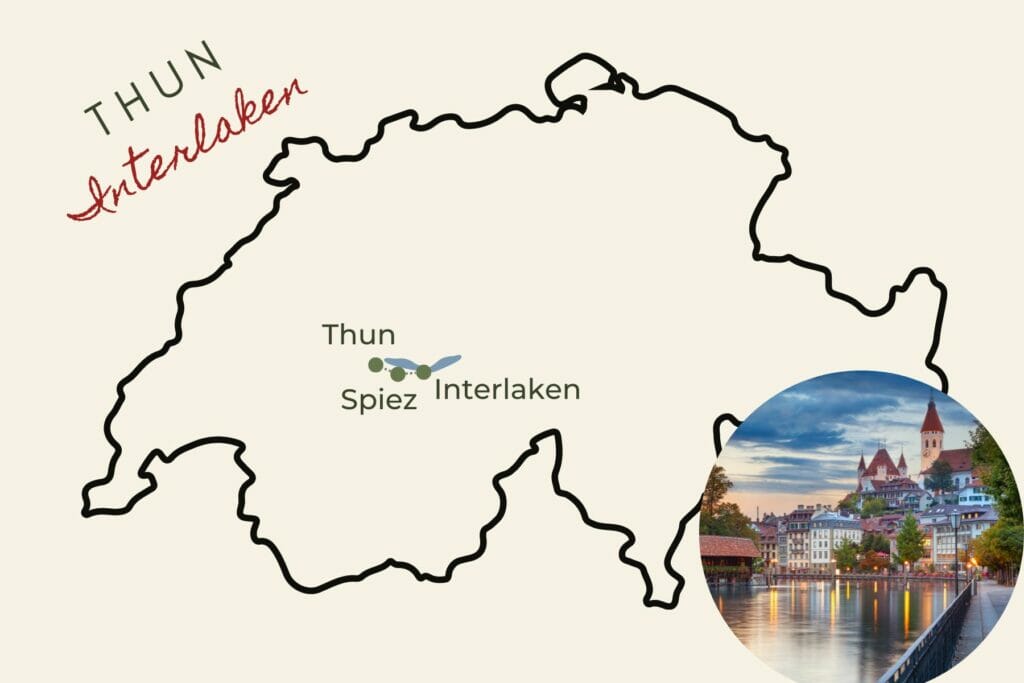
If you take this line, it is possible to go out in Spiez to enjoy the view and visit this lovely little town (and its castle). Thun and Spiez are really nice cities in Switzerland but they are not necessarily the most known, many travelers go directly to Interlaken (which is certainly very nice too but it doesn’t prevent to see the others) 😉
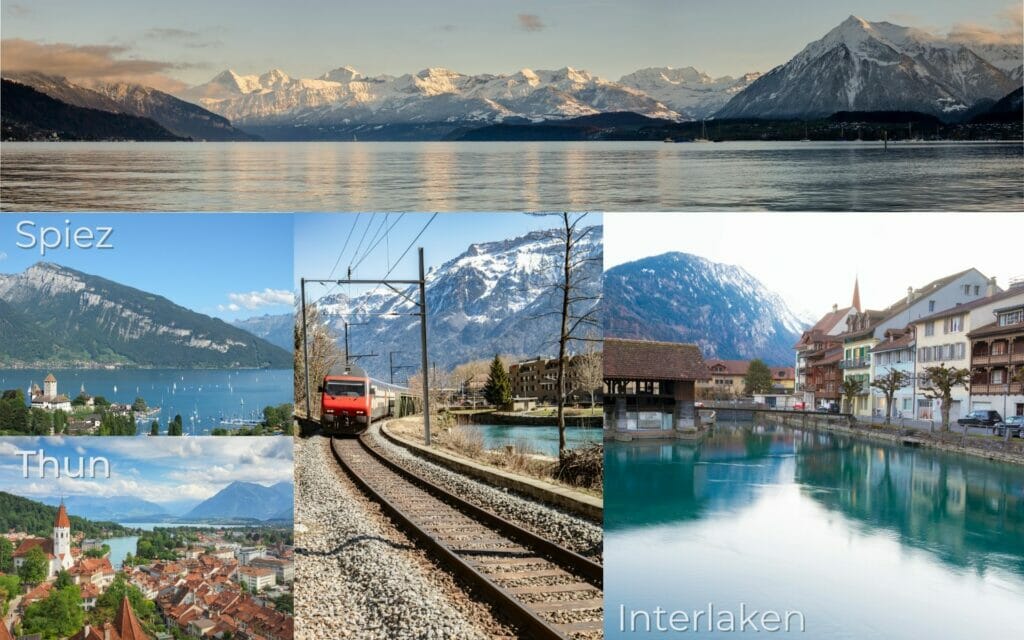
The Brienzer Rothorn
We leave the public transport network to go on a line managed by an association: the Brienzer Rothorn steam train. We took this train for the first time during the autumn of 2022, and sincerely… Wouah!!! Impossible to write a blog post about the most beautiful train lines and not include this one.
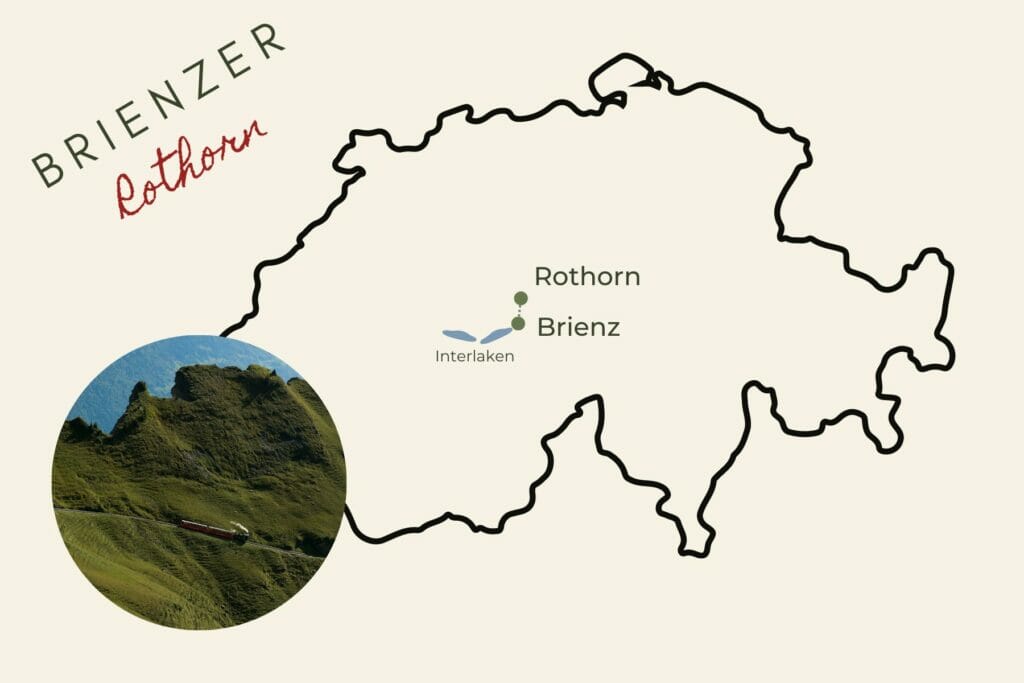
Between the steam train experience and the breathtaking views, I can’t tell you what we liked best. If you want to know more about this train, we invite you to read our post dedicated to this beautiful excursion.
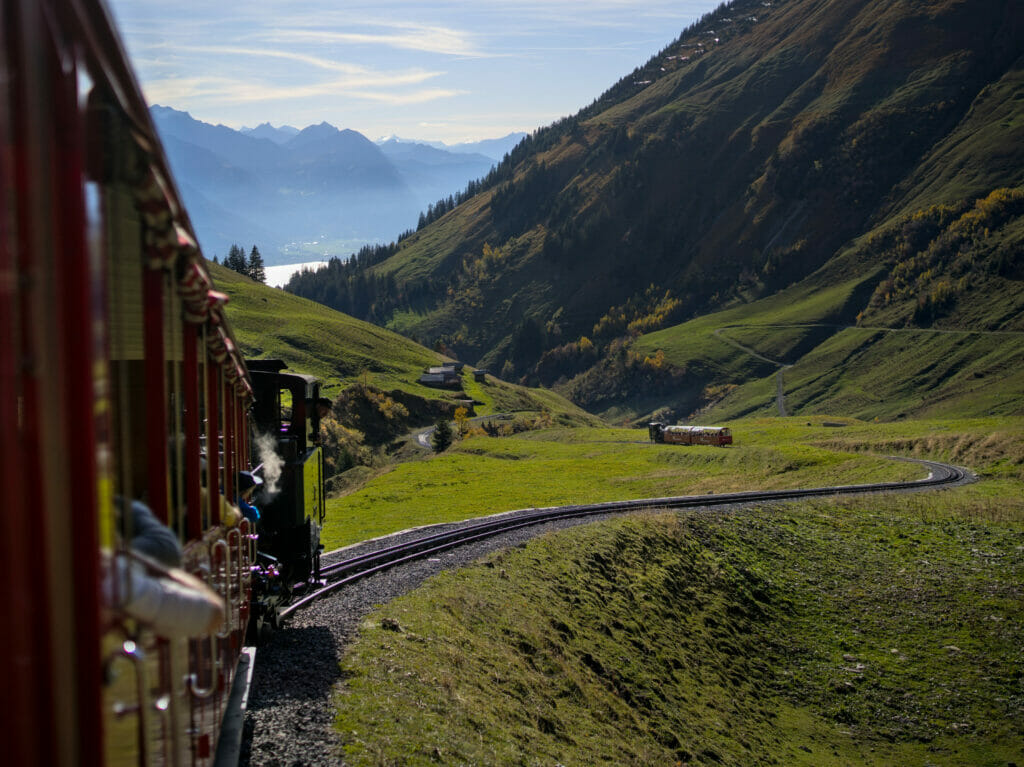
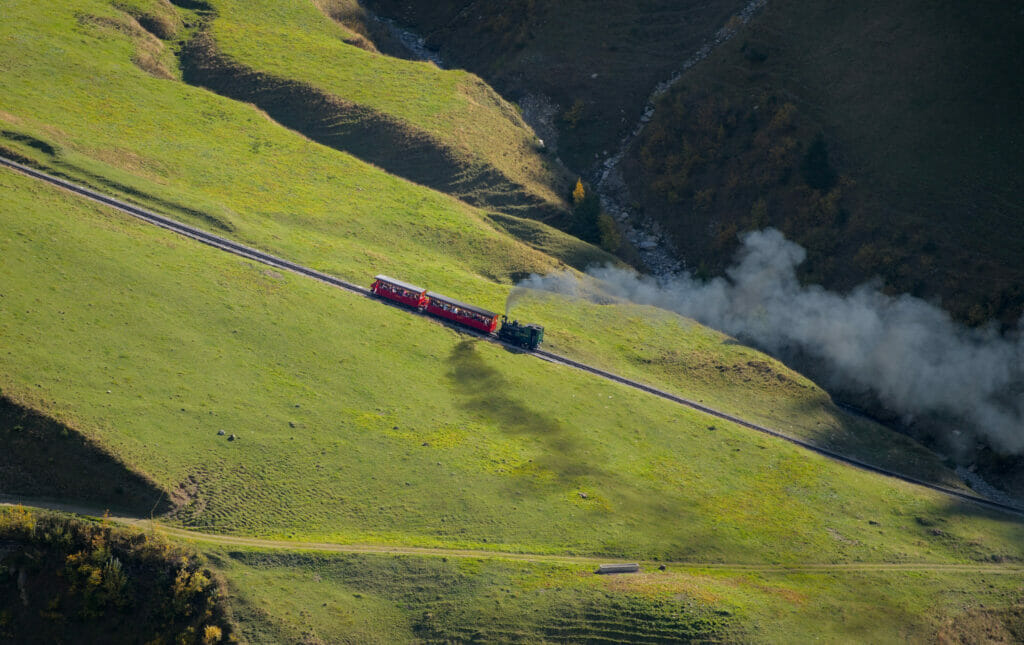
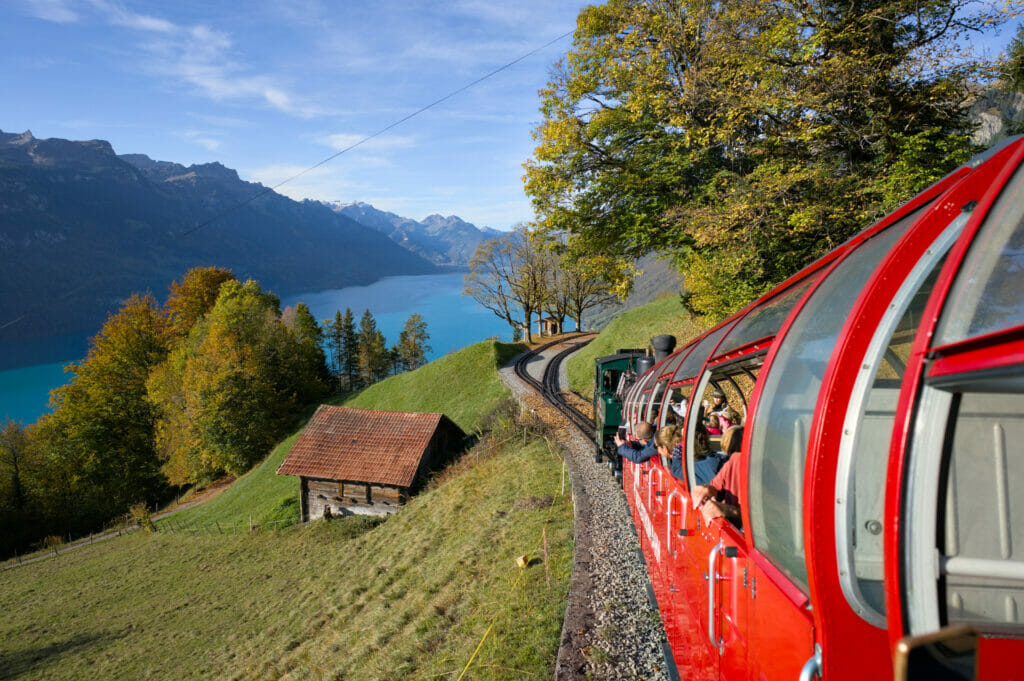

All the way up to the top of Europe – JungfrauJoch
We finish this selection by a train that we have not yet taken “to the end”. The Jungfraubahn is a mythical train for the good and simple reason that it makes it possible to reach the highest train station of Europe located at 3454m (yep!).

We didn’t go any higher than the Kleine Scheidegg (from this point on, there is an extra charge for the last stretch – not included in the GA or Swiss Travel Pass). No doubt that the experience is quite unique! From up there, you have a breathtaking view of the Aletsch glacier and the most iconic peaks of the Alps. If you are coming to the Lauterbrunnen area and are looking for some ideas for hiking in the area, please check out our article.
If you want to buy a ticket for the JungfrauJoch, you can check the prices on Getyourguide.
That’s it for our little selection of Swiss panoramic trains. We hope it will give you some nice ideas to explore the country. 🙂 And if you are thinking about traveling by train in Switzerland but don’t know yet what kind of ticket to take (individual tickets, Swiss pass, half-fare card), check this article.
See you soon
Pin it
